
Figure 1. The Noah's Ark Relic.
The Great Flood and Noah's Ark legend is common to the Christian, Jewish and Moslem religions. But as often occurs with religious beliefs, few have analyzed the Ark's nautical restrictions. Instead, a common belief exists that it was a simple rectangular vessel built by a single man and his extended family. Nothing could be further from the truth. The Ark's relic has been found (and re-found time and again) in the mountains of Ararat. Matching biblical parameters, it was 64% longer than any modern wooden vessel and had an (unloaded) displacement greater than that of a modern British aircraft carrier.
Government (Los Alamos) personal, once helpful with tests and measurements of it, no longer believe this relic to be Noah's Ark. No wonder, it clearly shows that it was NOT built by humans ~5200 years ago. It offers details of alien engineering principles involving the Golden Ratio. Its metallurgy shows ironwork not even possible until ~3200 years ago as well as the presence of other metals (e.g. titanium and aluminum) that would have been difficult to fabricate even in the early twentieth century. The Book of Noah explicitly specifies that "angels" (with extensive metallurgical skills) built the Ark. They were likely the Nommos, an amphibian species reportedly from the Sirius star system. They left mankind with cuneiform writing and the wheeled vehicle (alien technology of that day). They offered us astronomical knowledge of their own and our solar system (including Vulcan) and evidence of a past major comet/meteorite Earth impact. Finally, they appear to have left repositories of technologies far more advanced than our own. Their story tells of an alien species' attempt to save a deceitful mankind from an approaching comet impact catastrophe that caused Noah's Great Flood. Apprehensively, they may have recently returned to again warn us of a similar impending impact event.

Moses, nearly 4300 years ago, saw Noah's Ark. The Ark was well-known in Josephus' time (the 1st century A.D.) because he mentioned it in the "Antiquities of the Jews" and that people were still visiting it and removing pieces of bitumen for amulets against imagined evils. A thousand years ago the Crusaders recognized it and carved crosses on the stones used to stabilize and anchor it.
The Ark Of Noah was discovered (or rediscovered) in mid-May of 1948 by a local Kurdish shepherd boy named Reshit Sarihan, who is still alive (Sep. 2000), in the village of Üzengili, Turkey. Üzengili, previously called "Nasar", was changed in the 1950's but still has Kurdish Ark story overtones. Note that "Nisir" was the Babylonian name for Noah's city. Heavy rain in May of 1948, combined with three noteworthy earthquakes, exposed the Ark's impression from the loose mud that had entrapped it for hundreds of years. The collapse revealed an erect Ark-like impression raising out of the terrain.
| Location | Latitude | Longitude | Elevation |
|---|---|---|---|
| Mt. Ararat | 39 o 42' | 44o 18' | 16,946 ft. |
| Fasold's Predicted Location | 39o 26' | 44o 15' | - |
| Anchor Stones #1 | 39o 37' 31.8" | 43o 59' 42.4" | - |
| Bow | 39o 26' 23.8" | 44o 14' 04.4" | 6,575 ft. |
| Middle | 39o 26' 26" | 44o 14' 05.3" | 6,524 ft. |
| Stern | 39o 26' 08" | 44o 14' 06.6" | 6,449 ft. |
In the 1950s, the Turkish Air Force took NATO photographs of the Ark 2 miles from the Iranian border. The original landing site was further "up mountain" where an impression of structure became petrified in mud-rock. An ancient mud-flow carried Ark down to its present location where remains and artifacts have been recovered. This site is recognized as Noah's Ark by the Islamic peoples and officially identified as such by Turkish Government. While the relic has been analyzed extensively by Fasold, Wyatt and Windsor, many Christians as well as The National Geographic Society ignore it. It is not in the US government's interest to recognize it. Instead, they would rather "sell" people on a fruitless search on Mount Ararat, 17 miles away. The chronology of Holocene volcanic activity associated with Mount Ararat is poorly documented. However, either archaeological excavations, oral history, historical records, or combination of these data provide solid evidence that volcanic eruptions of Mount Ararat occurred in 2500–2400 BC, 550 BC, possibly in 1450 AD and 1783 AD, and definitely in 1840 AD. . . Archaeological evidence demonstrates that explosive eruptions and pyroclastic flows from the northwest flank of Mount Ararat destroyed and buried at least one Koura–Arax culture settlement and caused numerous fatalities in 2500–2400 BC. Oral histories indicated that a significant eruption of uncertain magitude occurred in 550 BC and minor eruptions of uncertain nature might have occurred in 1450 AD and 1783 AD. The Biblical scriptures (Genesis 8:4) say Ark came to rest "upon the mountains of Ararat", not "on Mount Ararat" an important difference. The anchor stones offers solid evidence that this is the Ark's location.
A Map Of Noah's Ark was published in "The Ark of Noah" (1985) by the late David Fasold. THE BABYLONIAN TRADITION that have come down from the Greek historian Berosus of the 4th century BC.
"Xisuthrus, son of Ardates was warned beforehand about the approaching Great Flood by the deity (alien?) Cronos, and told to build a ship and trust himself fearlessly to the deep, whereupon he built "a vessel 5 stadia long and 2 stadia broad." Actually, these dimensions referred to a 5:2 (right-angle) survey triangle. Using Berosus' description and a compass Fasold measured 706.1 nautical miles at a bearing of 324o from the Tomb of Darius (at Persepolis) to where this line intersects the ancient Persian Empire Prime Meridian (8o 35' West). He theoretically triangulated the Ark's anticipated modern coordinates of 39o 26' North, 44o 15' East (within a half mile of this artifact's actual GPS location). See Table 1. Historians from ancient times up until the Inquisition recognized this as the Ark's actual location.
Newton protégé William Whiston (1667 - 1752) took upon himself the task of differentiating the claims of science and religion. His central belief was that biblical and scientific accounts of the deluge could be reconciled. He presented this view in "A New Theory of the Earth" written in 1696, where it was argued that a comet impact was the probable origin of the deluge (i.e Noah's Great Flood). While Whiston's theory was controversial, he received support from Halley, Locke and from Newton himself. Christ clearly correlated the "end times" with Noah's Flood in Genesis:
If this is Noah's Ark, why isn't it front page news?. While the story has made the tabloids and appeared on network news, it has certainly been aggressively repressed from the main-stream consciousness. If it were an alien artifact, neither the US government, nor its covertly controlled media, would direct attention to it. Los Alamos National Laboratories have been suspected of silencing knowledge of extra terrestrial alien contacts since Roswell - July 1947 and they have been involved in this relic's investigation. Another reason it may have been repressed is that it so clearly illustrates the dangers of meteorite impact catastrophes. And there could be an alien presence that aids humanity during times of catastrophic collisions. Noah's Ark offers the most dramatic example of these past interventions. Further, there are also alien predictions of an impending catastrophe. The Ark and its related technology offer the clearest evidence yet of past alien intervention in human affairs.
Comet impact predictions have been made by several sources and seem to cluster around 2006 - 2016 AD. These predictions are often associated with UfO activity and UFO reports are certainly in current abundance. Christ's predicted catastrophe may soon be upon us. This is likely the reason for the suppression of this relic's discovery. But first, focus on when Noah's Great Flood occurred.
Almost everyone is familiar with the story of Noah and the Great Flood. See Appendix A for the biblical rendition. Theologians and historians have attempted dating this event, both recently and as far back as the time of Christ. The following are some of the results from these attempts:
Did a Comet Cause the Great Flood?
Masse’s biggest idea is that some 5,000 years ago, a 3- mile-wide ball of rock and ice swung around the sun and smashed into the ocean off the coast of Madagascar. The ensuing cataclysm sent a series of 600-foot-high tsunamis crashing against the world’s coastlines and injected plumes of superheated water vapor and aerosol particulates into the atmosphere. Within hours, the infusion of heat and moisture blasted its way into jet streams and spawned superhurricanes that pummeled the other side of the planet. For about a week, material ejected into the atmosphere plunged the world into darkness. All told, up to 80 percent of the world’s population may have perished, making it the single most lethal event in history.The Burckle Crater is thought to be the result of this impact.
The Burckle Crater is an undersea crater the Holocene Impact Working Group considered likely to have been formed by a very large scale and relatively recent (c. 2800-3000 BC) comet or meteorite impact event. It is estimated to be about 30 km (18 mi) in diameter [1], hence about 25 times larger than Meteor Crater.A tsunami also resulted from a comet/meteor strike near the Caspian sea (forming the adjacent depression known as Kara-Bogaz-Gol). This impact could easily have created one such localized flood. The water lifted the Ark from the plains west of the Caspian and deposited it in the Araxes valley. See Figure 2.It is located to the east of Madagascar and west of Western Australia in the southern Indian ocean. Its position was determined in 2006 by the same group using evidence of its existence from prehistoric chevron dune formations in Australia and Madagascar that allowed them to triangulate its location.
Burckle Crater lies at 30.865oS 61.365oE Coordinates: 30.865oS 61.365oE in the Indian Ocean and is 12,500 feet (3,800 m) below the surface.

Biblical catastrophes like Sodom and Gomorrah record even the mild havoc caused by heavenly bodies around 2300 BCE - give or take a few hundred years occured later. Around 2213 BC. These impacts cause lesser havoc, still the world's first urban civilizations fell away, all in a short period of time. It was the same in Egypt, Israel and Mesopotamia. Two-thirds of all settlements were destroyed or abandoned. Genesis states that:
Sumerians were the first to develop cuneiform writing around 3200 or 3300 BC (just before the Great Flood). It used wedge-shaped characters and recorded the first epics in world history, including the Epic Of Gilgamesh (the earliest story of the Great Flood) about 500 years later. All early civilizations regarded writing as very magical. Note also that the Sumerians were the first to use wheeled vehicles, first sail for long-distance travel, arches, columns, and ramps, inclined walks 3200 BC. Perhaps man invented neither the wheel nor writing. The Vulcan web site's Synopsis section favors the Great Flood's date to be 3195 BC based on tree ring data. This date is supported by both Paleoclimatalogical data as well as theological data. The Paleoclimatalogical data references below also indicate that a crustal shifts accompanied the Great Flood (causing a "super-tide"). Furthermore, notice that the average of Josephus Dr. Hales Septuagint Great Flood date is 3183 BC years, close to the 3195 BC tree ring date.
Most people assume that Noah built the Ark. But the THE BOOK OF ENOCH. CHAPTER 65 (Book of Noah) clearly states that the angels were its builders. Perhaps the angels mentioned therein were extra-terrestrial aliens. The record suggests that human's fear and distrust surround their efforts. Either that (or deception by their leaders) was why only eight choose to board the Ark while the rest waited in ignorance of the impending catastrophe. The Ark was large enough to carry many to safety. Selected verses from the Book of Noah (found within the Book of Enoch) are listed below. Comments possibly related to aliens are italicized.
Who were the angels? In a passage from the book of Noah, there's an explicit reference to the angels who "infringed the word of the Lord, the law of the sky". This tale, just before the Flood, is confirmed by the Dead Sea srolls. The story describes the fall of 200 angels, called Vigilants, who came down on Mount Hermon (north of Palestine). A Vigilant called Azazel taught men how to build weapons & armor and how to manipulate metals. Other Vigilants taught magical arts like clouds, meteorology, signs of Earth and astronomy. Peneum, another Vigilant, taught the use of spices in the food and also ink and paper. The Vigilants specifically are cited as those who introduced (cuneiform) writing.
The Nommos, aliens from the Sirius star system, reportedly visited Earth at the time of Noah's Flood. Thus, they may have been the angels who built the Ark. Sirius is in the proper galactic region to support sentient life. See Galactic Life - Local Limitations. The U.S. Naval Observatory claims that planetary orbits in the "habitable" zone are unstable. An Earth-type planet could contain liquid water about 4.6 AU from 300 million years old Sirius A. But simulations suggest stable orbits exist at circumstellar distances around both stars up to more than half the binary's closest separation (8.1 AU). Sirus C, companion to B at 1.4" suspected but not confirmed". and this flare star could host a habitable plane where an amphibious or ant like species could exist.


They landed on Earth in an "ark" that made a spinning decent with thunderous vibrating noise and wind. The Dogon draw its decent as four concentric circles implying circular motion of the vehicle.2 Flight path continuity demands the circles be connected like the UFO's spiral decent depicted in the photograph shown in Figure 3.
The Dogon believe that Sirius B occupied the place where our Sun is now. Clearly this is not literally true. Temple associates another star, Sirius C (Emme Ya) with Sirius B (Digitaria or po tolo).3 Then Sirius B would be analogous to our Sun and Sirius C to Vulcan (our unlit Sun's companion star - a main theme of this web site).Further, there is confusion as to why the Dogon hold their celebrations every 60 years when Sirius B orbits Sirius A every 50 years, Obviously, the 60-year cycle is relevant to our own solar system and is utilized in Chinese astrology.
The knowledge about our solar system (including Vulcan), as displayed on the Akkadian Seal, is attributable to the Nommos. Should they have detected and formulated Vulcan's orbit from their own solar system, it is just a matter of mathematics to deduce when a swarm or cluster may be threatening Earth. Noah's Flood was from a comet strike due to passage of swarm A cluster Cl – 1.
It is really not known where the Ark was built as the Nommos activity was globally widespread. Most sources suggest that the Ark was built in Mesopotamia. But high mountain ranges exist between there and the Ararat mountains. If the Ark were built near the Caspian Sea, the intervening mountains would not have been too high. The movie "Deep Impact" offers an example of a tsunami generated by a nearby one-kilometer comet deep-sea impact and it reaches into the Appalachians. The Kara-Bogaz-Gol (western side of the Caspian) is another possible strike location. Should the comet have come out of the northwest (not having yet rounded the Sun), it could have induced massive "super-tides" from slippage of the Earth's tectonic plates towards the southeast. Thus, a strike on solid ground would generate a "super-tide" that would seem to move towards the northwest. The theological data reports that there were multiple impacts as if a comet broke apart during its flight through our atmosphere. Thus, there was a vast wave (super-tide) that united with other waters from more southern latitudes.
Should a comet strike have caused Noah's Flood, there would be a tremendous amount or residual dust in the air. Much of it could come from the impact of smaller debris that often accompanies a comet originating from the Kuiper belt. This, combined with the relative warmth of the water (either from their pre- flood ambient conditions or from the energy released by the comet strike itself) would have caused heavy fogs to occur both day and night. Warm water meeting the cold air, that occurs at more than 6,000-foot altitudes, would have quickly resulted in such natural fogs. Additionally, volcanic activity of parts of the Ararat range could result from the strike. These could be present on a hemispheric wide basis shortly after the strike. Tree Ring data clearly shows the presence of the cold environment this strike may have caused 3195 BC. Some lifting of this fog could be why the "mountains of Ararat" appeared to emerge months after the initial comet strike.
Should this artifact be Noah's Ark, its landing sight is well known. A large number of the Ark's anchor stones are found near Kazan, Turkey. The village of Kazan lies just north of a large rock formation (called the Bed of Heroes) that could have been used as a temporary "anchorage" while waiting for a suitable landing area to appear. The topography indicates that the anchorage on Mt. Cudi near the rock outcropping was a relatively fortunate location. The place where the Ark may have finally been "beached" was the last protected cul-de-sac in Turkey before an outlet into the next lower valley eastward into present day Iran. Noah appears to have "cast off" from his protected anchorage when a natural dam broke 150 miles to his east. Fortunately, the topography may have been well know to the Nommos who might have had mapped it from their space-born vantage point. They could have directed the Ark to a "fortuitous beaching location" just as the dam broke. Otherwise, much luck would have been involved as well as a traumatic ride. Should Noah have missed this beach site, the Ark would have rocketed to the next lower valley, breaking up on the way breaking up from collisions.
God commanded Noah to build a ship, the Ark, and as he was building it, the chieftains passed him and mocked him. Upon its completion, the ship is said to be loaded with pairs of every animal available that time, and Noah's household,[38] and a group of believers who did submit to God. The people who denied the message of Noah, including one of his own sons, drowned.[39] The final resting place of the ship was referred to as Mount Judi.
For Muslims, Noah was married to a woman whose name is not mentioned in the Qu'ran. Some Islamic historians such as Al-Tabari have suggested that the name of Noah's wife was Umzrah bint Barakil but this cannot be confirmed. Most Muslims simply call her by her biblical name Naamah.[7] Islamic scholars agree that Noah had four sons whose names were Ham, Shem, Yam and Japheth. According to the Quran, one of Noah's sons was a disbeliever who refused to come aboard the Ark, instead preferring to climb a mountain, where he drowned. It is agreed among most Islamic scholars that Yam was the one who drowned; the other three remained believers.
Many mud-flows occurred around the Ark during the last 5,200 years. The figure shown on this hyper- link shows the local topography. This is the actual 1959 Turkish Air Force mapping photograph taken by Air Force pilot Sevkit Kurtis. The purple arrows represent a path of mud flows ending in a circle representing the Ark area. The upper, white plateau section is Iran and below the escarpment (shadow of cliffs) is Turkey. Down in the lower, right-hand section in convergence of several mudflows, is seen the elliptical Ark remains. The mud-flows have moved the Ark from its original beaching position nearly two miles to its current location. It is near the old "silk trail" road into Iran, and many could have visited it as Josephus reports, and chipped off bitumen to sell as amulets that could ward off evil.
Naxaum is believed to be the oldest post flood city. It is found in and around the Ark discovery area. Artist/author David Deal illustrated this "House Map" of Naxuam. It is a rendition of Naxuan's city map as derived from a satellite photograph suggesting foundations of ancient buildings.
The site of the remains of Noah's Ark on a mountain across the valley from the much-favored Mount Ararat is, and probably will be controversial until all of the evidence is excavated from this amazing location. First, and very briefly, there are the Ark remains in the form of a 538 foot long boat impression in a mud-flow adjacent to the Kurdish village of Uzengili. The boat shape is a double-ender in classical shipbuilding terms and necessarily so, for the Ark of Noah was a nautical design, not a large shipping container. This structure is not a naturally occurring one. Geologist have looked at it, and no honest, reliable geologist will claim that it is natural, except perhaps someone like radical evolutionist ( & skeptic) Ian Plimer of Australia (who has been recently discredited in an Australian court for his zealous and untruthful attacks on those who believe that there was a flood and wants to discuss it publicly). We should be skeptical of Mr. Plimer whose irrational and ultra-zealous attacks on Noah's Ark or flood believers has caused him not a few problems at home.
The traditional box-shaped ark has become a reality in most minds because of the square dimensions given in the Bible. What is not generally known however is that ships are referred to in three measurements: first the length, which is a hard number, and an actual measurement of length. The second number always refers to the average width, given that a ship is wider in the midships section than at either end. This figure is ALWAYS an average of width. And finally the height dimension which includes the hull and superstructure if any. The dimensions of the Ark-mold shape at Uzengili on the slopes of the mountain called locally Cudi Dagi (pronounced Judi in Turkish), fit precisely into a 50 x 300 square-measure rectangle using the 22 inch cubit. It is an assumption that the 18 inch Hebrew cubit was used in the Ark's construction. One will notice that the actual length of the cubit is nowhere given in the Bible. The site of the Ark of Noah on Cudi Dagi is, for now, going to have to be left to the reader's evaluation of the photographic and geologic evidence thus far gathered. Several photos will be presented here.
The name for the mountain "Cudi" makes reference to the first and longest lasting inhabitants the Kurds. Josephus claims that the ark landed in the mountains of "Cordyaeans" meaning Kurds. The actual name of the mountain is Cudi Dagi which means "mountain of the Kurds." In Hebrew the word kHD (Strong's # 2298) means "first." Cudi was the first landfall, the first human habitation, and the present inhabitants still refer to themselves as Kurds. The Kurds at some past time must have seen themselves as the first people in the area. Thus the importance of the original name of the mountain, phonetically "kHudi" cannot be over- stressed. (Judi is a Turkish and Arabic pronunciation based on the difficulty in pronouncing the Shemetic kH (cHayth) used at the time of Noah. It is a gutteral explosive growl sound. It may be transliterated as C, Kh, Ch, and perhaps has even crossed over to Jh, as the evidence seems to suggest, hence "Judi." is an early Chaldeanattempt at vocalization. (because Berosus made the claim first).
I was given a 1959 Turkish Air Force mapping photographic negative by Dave Fasold, which was given to him by Rene Noorbergen. It clearly shows the Ark stuck in the mud-flow. What attracted my attention was the fact that it was impaled on a large rock outcrop. My reasoning was that it must have slid down from higher up on the mountain, which indeed it had. I made a 16" x 20" enlargement of a 3"x 5" section of the negative and soon found the impression where the Ark had originally touched down. Here was a clear outline, highlighted by the sun, of the berm created by the great ship, lying hard against a thirty foot high escarpment of limestone where Noah had landed her. The outline was precisely the same shape and size of the Ark-mold a mile farther down the hill and 1,200 feet lower where it had obviously slid after many years -perhaps by earthquake and rain to soften the earth. One may see this in the accompanying 1959 photo. This detail had not been previously noticed.
This led me to send a copy to Professor Salih Bayraktutan with Dave Fasold for further evaluation. Later, I made an even larger blow-up and began to see hundreds of house foundations. In the final analysis, there were at least a thousand still visible rectangular depressions in the area. Here was the long- lost city of Mesha- Naxuan, referred to in the Bible (Genesis 10:30) and by Gilgamesh as the "Mountains of Mashu," where Noah and the flood survivors built the first city. Other writers have also mentioned it, they include Claudius Ptolomy, Josephus, and Armenian historian, Moses of Chronensis.
The Bible Code appears to offer data that supports the ET alien involvement with Noah's Ark and that it is likely going to be found near the 'End Times' (when an impending cosmic catastrophe is threatening). What is worse, the dates of 2011 to 2016 and 'Obama' are mentioned and this web site predicts a 2016 to 2017 date.
Except for Phoebe, the satellites of Saturn orbit close to it and in nearly posigrade circular orbits. Most (except for Iapetus and Phoebe) are found at orbital inclinations close to Saturn's spin plane. Seven are tiny (a few tens of kilometers in size) and are probably captured asteroids or residue from a "detonated" tiny satellite that produced Saturn's rings. Phoebe is almost four times as distant as Iapetus, Saturn's most remote major satellite, and in an elliptical retrograde orbit. Phoebe's orbital plane is close to the ecliptic (the plane in which Earth and most other planets orbit the Sun), rather than in Saturn’s equatorial spin plane as are most of Saturn's other satellites. If Phoebe were moved from Earth orbit to an orbit about Saturn, it is reasonable to expect that it would be inserted in a more distant orbit than any of the other major satellites and in an elliptical orbit contained in the ecliptic plane because Earth is likewise located in the ecliptic plane. The reason for its retrograde motion is not clearly understood, but it stands out from the posigrade motion of Saturn's other satellites.
Anchor or drogue
stones were among the first items discovered at the Ark site. They were
used to keep it stable in rough seas, to anchor the Ark, or maneuver the vessel
during beaching. About a dozen of a probable two dozen such stones weighing
from seven to ten tons each have been found. The Crusaders marked these stones
with crosses acknowledging Noah and his extended family's voyage.
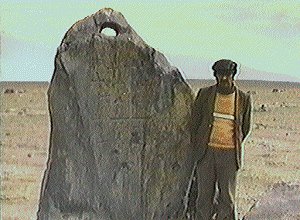

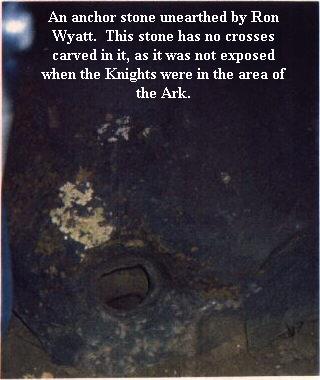
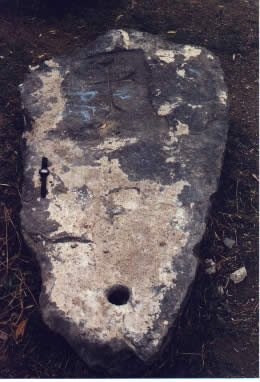
Depictions of other anchor stones like the one in Figure 4 can be found below.
The remains of Noah's Vessel had been covered by mud and volcanic ash, but the shape of the vessel is clearly resolvable especially after the heavy rains and earthquakes have disbursed much of the obscuring mud in 1948. The sharp-ended stern is uphill (about 98' higher) than the rounded bow. This is just opposite what one would expect if it were a natural formation. We must also remember that the Ark was covered by a disintegrated lava (from magma) mud slide, and became gradually petrified with molecules of the substance in the earth ABOVE the Ark, which were minerals.
The anchor stones are located about twelve miles from the Ark relic (shown in Figure 5). The gentle grade of the place where the Ark was beached is the only such local site at this elevation east of the anchor stones' location. It could accommodate such a large vessel and permit it to be successfully off loaded. All other such large, "beach like" landing sites are at lower elevation lake bottom locations. This site is the last available one west of a steep downhill slope.
The terrain on the way in may not have presented the same obstacles to the Ark as it did on the way out. The water depth from the tsunami or super-tide combinations generated by the comet's impact was much greater onto the land and was at a very much higher flow rate than the water's recession. But without much flood depth, the Ark faced limited options on its downhill journey. The water trapped in high, intermountain basins forced the Ark to beach in the highest location available, or run "rapids" down into each successive lake. The first such run would probably have destroyed it. Noah must have had a wild ride from the anchor site to the beach site. Apparently, the Ark cast off from its protected anchorage, perhaps when those controlling it were informed that a water dam broke 150 miles to the east. It is doubtful that a small collection of confused humans would know what to do. Further, the Ark had to be maneuvered with very little margin for error. Windsor8 feels that Noah would have had to take depth soundings to inform him that the potential beaching area was fairly level. Alternately, the aliens (Nommos) had mapped the area previously, and they could direct the Ark "from above". Once on the move, there was little choice but to follow the currents and grab the first beach site available.
The Cuneiform Tablets found in the Epic Of Gilgamesh supports this scenario:
"After embarking, the storm broke with fearful violence and the steering of the ship was handed over to Bezur-Bel, the ship man. But amidst the roll of thunder and the march of mountain waves the helm was wrenched from the pilot's hands and the pouring rain and the lightning flashes dismayed all hearts. "Like a battle charge upon mankind" the water rushed so that the gods even were dismayed at the flood and cowered like dogs, taking refuge in the heaven of Anu while Ishtar (the winds?) screamed like a woman in travail."Notice that the "gods" take to the heavens, possibly to help the Ark's ship handlers who may also be aliens. Communications between the Ark and the aliens would be most critical at this time.
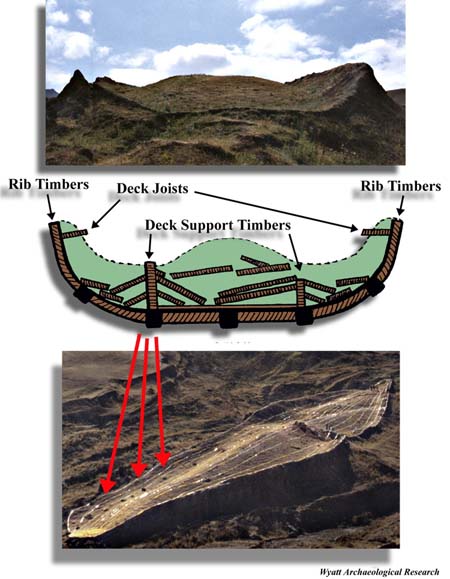
Mapping of the Ark's bulkheads was no casual affair.
Sophisticated ground penetrating radar was employed to outline the remains of
the relic. See Figure 6. Ground penetrating radar proved the boat to have three
decks, the top two decks had collapsed leaving the bottom deck intact which
contained 144 rooms. Walls, cavities, a door near the front, ramps, and two
large 14'
by 24' barrels near to the bow were also located. The radar scan
revealed four protrusions extending from the stern that were probably
stabilizers.


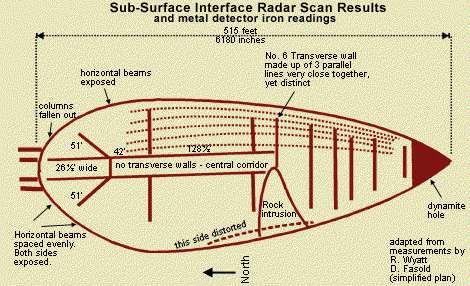
Ron Wyatt, Dave Fassold and John Baumgardner surveyed the site with metal
detectors and found a U -
shaped item which had the appearance of 'wrought iron.' See Figure 7. It was
reported by Dave Fassold that the semi-quantitative analysis of the iron
samples,
which was arranged by John Baumgardner, found them to contain from 60 percent to
91.84 percent Fe2O3. Sub-surface radar is a device built
by Geophysical Survey Systems Incorporated (GSSI) that can chart the presence of
objects below the surface. A metal detector found about 3,400 iron masses, and
these were mostly spaced at a nominal 21-inch interval. A total of 5,400 such
places (both estimated and found) show linear patterns consistent with the shape
of the hull. Stakes were driven at these locations and yellow surveyors ribbon
laid on the ground over them. They depicted both contoured patterns of
longitudinal and transverse lines. The Ark had apparently slid downhill after
beaching (possibly at a much later date) and struck a rock. One part of the
forward port side was impaled, and the location lines compressed neatly around
the rock. Joe Rosetta, vice-president of Geophysical Survey Systems, reviews the
sub-surface radar scans. His conclusion: “This is not a natural object. The
reflections are occurring too periodic for it to be a natural type interface."
"You’d never see anything like this in natural geology…. Some human made this
structure, whatever it is." As this was found in a structure of this artifact is almost identical with those
mentioned in the Bible -
assuming the Royal Egyptian cubit is used.
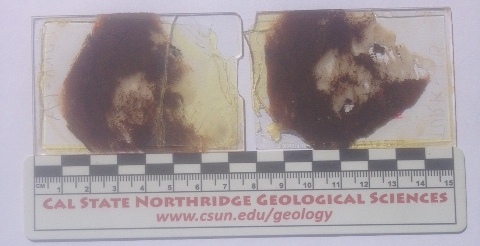
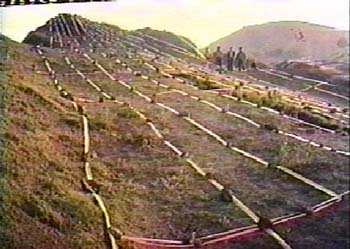
Rivets or some sort of metallic fasteners were also found by Wyatt. See
Figure 8. The fossilized object shows circular impressions left from
striking an apparently heated metal rivet.
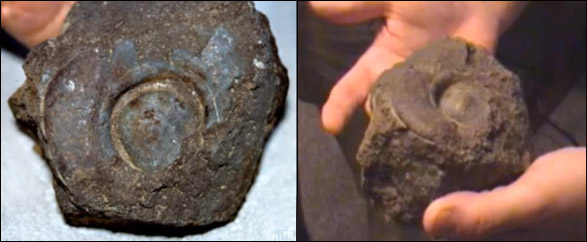
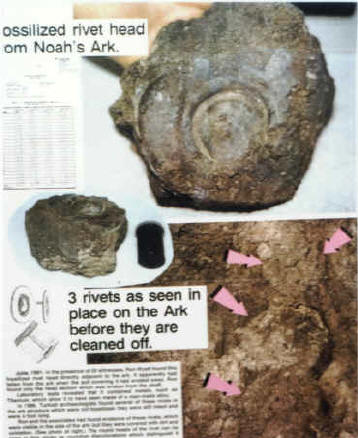
The Ark relic shows evidence of vertical and horizontal support structures. There is marginal evidence that recovered joints structures indicate that they were held together with hexagonal arrays of six rivets with a seventh central rivet.
Figure 9 shows the outline of the hull that reveals vertical slabs (Rib-Slabs)
of "something" that was placed along the hull's exterior. Their purpose is
believed to be to protect the softer reed structures from contact damage. The
hull and superstructure were formed of reeds laid in a sealing cement-like
material. Then the sides, including the inside of the Moon Pool (discussed later), was coated with a bituminous clay compound. The
curved vertical slabs were affixed outside the sealed hull. There are color
difference in the lighter soil areas that appear to resemble 'rib timbers' as
contrasted against the darker soil. The rib timbers were found to be fragmented
and to be held in place by the surrounding material. These are believed by the
Turkish
Government to be 'rib timbers' (or what is left of them). At the very least, these are
suspicious structures found in a structure that matches the biblical dimensions
of Noah's Ark.
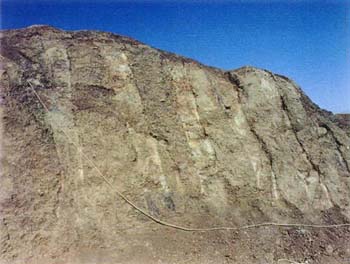

An unusual chip of rock is found about two miles west of Kazan. See Figure 10.
When it is tapped with a rock, it emits a hollow sound. It is about 16 inches
thick and appears to have been made of bundled reeds. There are seven crosses
inscribed in it. This is in an area that has very few trees. This is thought
to be part of the Ark's deckhouse, but there is no certain way to tell where it
may have come from.
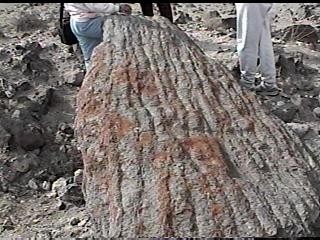
Figure 11 is a petrified wood samples recovered from the Ark site using Ground Penetration Radar to locate a structural member. Its collection was done under Turkish government supervision. Specifically:
"Governor Ekinci issued instructions that the American crew was to stay upon the hill. They were not to film this event, for it was his. He allowed some journalists, a Turkish cameraman, some members of the military, and other dignitaries only to witness the next events. . . The Governor then order one of the soldiers to dig at the location Ron had indicated, which he did. There soon emerged what looked like a flat rock. As more dirt was removed, it could be seen that it was about 18 inches long and it was then removed. All captured on film, it was obvious that it was a petrified section of a hand-hewn timber! . . . The Governor . . . told Ron Wyatt to take it to the States and have it tested. He then placed it in the radar case, which would protect the extremely valuable specimen during transport. The entire event was shown throughout Turkey on TRT (Turkish Radio and Television). . . "

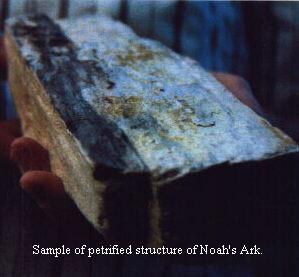
Figure 12 shows a close-up photo of an 18 inch deck plank unearthed before Turkish officials by Ron Wyatt and features three distinct layers of wood with glue (dark pitch) on top. The glue oozed from the layers. The outside of the wood appears to have been coated with bitumen. It was tested and proved to be petrified wood. It is 18 inches in length and has two visible nails with dark pitch on top. Tests by Galbraith Labs showed the sample to contain over 0.7% organic carbon, consistent with fossilized wood. It was once living matter. Even more surprising there were iron nails embedded in the wood! See the red arrows in the below figure.
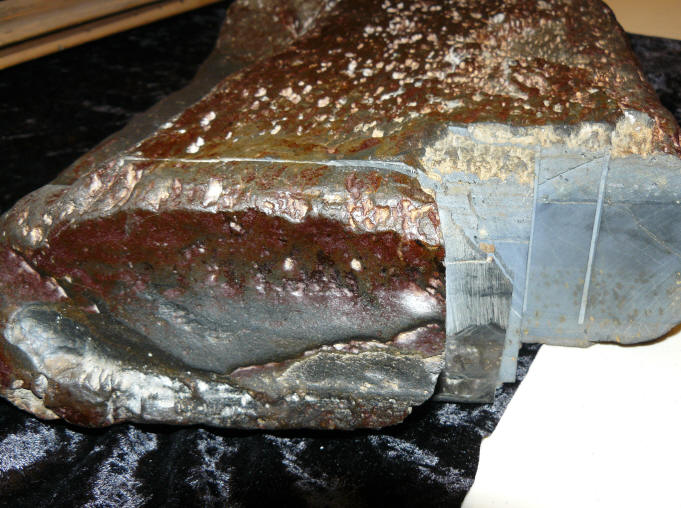
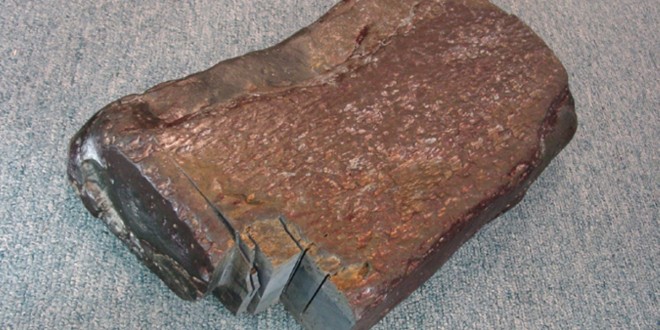

The test
result showed it almost totally petrified, with only
0.71% total carbon, but only 0.0081% inorganic while 0.7019% organic -
a 100 times more organic than inorganic carbon! Laboratory analysis was
performed on artifact labeled "deck timber". Galbraith
Labs in Knoxville, Tennessee tested samples taken both from within the
"formation' and from without. All of the laboratory procedures were videotaped,
including the taking the sample from the specimen, and the actual execution of
the analyses.
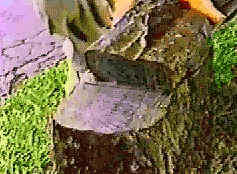
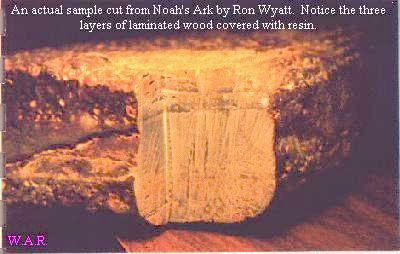
Other petrified wood samples were also excavated in the presence of a number of Turkish officials. One piece was sawn in several places, exposing lamination of 3 layers exposing the wood grain. See Figure 13. Wyatt considers the petrified wood to be laminated and it contained a much higher carbon content than the surrounding area (4.95% carbon compared to 1.88% for specimens from the surrounding area). The high concentration of carbon was consistent with the presence of prior living matter, such as decayed or petrified wood. It also showed a surprisingly high iron content. Thin sections revealed that it consisted of three laminated layers. Despite these finds, petrified wood offers the weakest evidence of the Ark relic because it is so easily formed.
Fibers also have been recovered from the Ark relic. Some fibers revealed all of the features characteristic of mammal hair while others some sort of plant fiber as the cellular structure was plainly visible. Another hair-like fiber was evaluated which revealed very unusual characteristics: the shaft was long and cylindrical like hair, but revealed nothing commonly associated with hair. Along the outer surface of the fiber, angular spines extended from the shaft. The specialists believed this to be some sort of plant fiber but all agreed that they had never seen anything like it. All this above was found in a structure whose gross measurements is almost identical with those mentioned in the Bible. And these matching parameters, combined with all of the above, leads to the inescapable conclusion that this artifact is, indeed, the remains of Noah's Ark.
From a 1959 Turkish Air Force mapping photographic negative, it clearly shows the Ark stuck in the mud-flow. It was impaled on a large rock outcrop and it must have slid down from higher up on the mountain. The negative shows the impression where the Ark had originally touched down. There was a clear outline of it, highlighted by the sun, of the berm created by the great ship, lying hard against a thirty foot high escarpment of limestone where it landed. The outline was precisely the same shape and size of the Ark-mold a mile farther down the hill and 1,200 feet lower where it had obviously slid after many years. One may see this in Figure 14 showing this part of the 1959 photo.

Summarizing the result of a June, 1991 joint Wyatt/Sunset International Bible Institute investigation of this artifact:
The metallurgy offers the initial clue that something unusual is associated with the Ark relic. Iron residue is found throughout, but the Iron Age did not start until about 800 BC in Egypt. It started earlier around 1100 BC or 1200 BC in Crete and Greece. There is some data that indicates that iron was obtained from local ores (not meteorites) as early as 2500 - 2700 BC by primitive metallurgical processes. Oxidized beads dating to 4000 BC have also been discovered. There is documented evidence that an iron tool was found in the Great Pyramid of Giza dating to 3100 BC around the time of the Noah's Flood.6 Adding to this consternation is the presence of a carbonized iron (steel) dagger in the museum at Ankera possibly dating as early as 2900 BC.
"Noah's Ark - The Evidence" lists the composition of many of the metallic finds. Note that chemical analyses are always reported as oxides because most metals oxidize over the course of thousands of years. These metallic residues shows not only is this relic the Ark of Noah, but also that its construction was by angels (or aliens as they are now called) as described previously in the book of Noah. Metal is found in the rivets, washers, brackets as well as the ballast spilled from a breach in the relic. Some of the results are considered below and the words are largely those of Mary Nell Wyatt.
| Metal Oxide | Percent composition |
|---|---|
| Al2O3 | 15.84 |
| Fe2O3 | 13.02 |
| CaO | 3.97 |
| MgO | 1.98 |
| TiO2 | 2.93 |
| SiO2 | 45.2 |
| K2O | 3.0 |
| Na2O | 3.44 |
| P2O5 | 1.23 |
| MnO2 | 0.3 |
| Metal Oxide | Manganese Sea Nodule | Ark Nodule |
|---|---|---|
| Manganese | 35% | 87% |
| Copper | 2.5% | 0.0% |
| Nickel | 2.0% | 0.0% |
| Cobalt | 0.2% | 0.0% |
The Ark relic has both its supporters and critics. Most notable is one of the original investigators, Dr. John Baumgardner of Los Alamos National Laboratory (who is well funded although his work is questionable). He no longer believes this artifact to be Noah's Ark.8 Los Alamos and the UFO mystery have been related since February 16, 1948 and "Project Twinkle." Some of the other critics have even not visited the 'Ark site'. These critics feel that they would not have sampled materials from the relic differently than Fasold if they had gone there themselves. Fasold brought back labeled specimens and map locations from all of the key places on the supposed relic. They were labeled as fossilized wood from alleged gunnels, staves, deck planking, walls, etc. and the black sands that were thought to be iron supports or anchors for masts holding sails and the supposed iron rivets or spikes that held the walls together.
A retired geologist also investigated some of the samples brought to him and found that they were common basalt. He may be right on this matter, but he is also biased in his evaluation of the documented Noah's Ark reports. For examples, he considers the Great Flood story to be just a shallow flood on the Mesopotamian Plaines with the Ark being just a large fishing boat. Thus, he rejects the Ark's dimensions as recorded in the Bible and its location on Mt. Cudi as recorded in the Koran. He also is extremely forceful in denying that this relic is the remains of Noah's Ark, almost acting as if he is on a personal crusade to do so. However, he may be correct in thinking that the sides of the 'Ark' defined in this relic are now mostly made of basalt. His 'zeal' in denying this relic makes his Ark related work questionable, and he has temporarily persuaded Fasold that this is not the Ark near the time of Fasold's death. Fasold recanted his denial just before he died. Remember, the secreting of Alien technology and related ET alien data seems to be the policy of the elite that largely control the USA government. The elite would like to keep knowledge of an impending impact event from the general public so they could have an advantage is one were to happened 'without much warning'.
The following are typical of this geologist's work, although they may have been edited by others. Microscopic thin sections were made of these samples. It was found that:
While this appears to condemn the metallurgical results, some problems remain.
The presence of such high concentrations of manganese and titanium and in such large samples was an immediate tip-off that the relic associated metals were made by beings of superior intelligence. Certainly ones of more intelligence than found in the indigenous human beings dwelling there - or any place else on the Earth of that day. Those humans existed two thousand years before the iron-age. No wonder the titanium caught Los Alamos' attention. No wonder their representative visited the Ark site. And no wonder they reversed themselves on the validity of this find at a latter date.
An article Did Ron Wyatt find Noah's ark? written by Andrew Snelling is an attempt to debunk the Finding of Noah's Ark.
Also, erosion could not have formed the vertical ribs on the outside walls of the ark for two reasons. First, water flowing down the mountain would create a horizontal inscription on the ark, not vertical. Second, it was not until 1978, when God sent an earthquake to drop the earth from around the sides of the ark, that any erosion could have started to take effect. But most importantly, when the earthquake took place, the sides of the ark were revealed and exposed for the first time ever, showing the vertical timbers in their natural, man-made state. Erosion had NOT formed them.
- First, Mr. Snelling says the rivet was found fifty yards away from the ark, when in fact it was found on the ark in front of 25 witnesses who each signed a statement testifying where it was found.
- Second, the rivet does not have a "vague" appearance, instead it has a definite shape of a man-made round washer with a center shaft, the end of which was struck and flared out to secure the washer in place.
- Third, analyses performed by Galbraith Labs, showed the rivet to contain 8.6 percent aluminum metal, 1.9 percent titanium metal, 10.38 percent iron, and .21 percent manganese. It is unfortunate that Snelling knows aluminum metal is a man-made substance, and yet he refuses to acknowledge the man-made qualities of the rivet.
- Fourth, basalt does not contain aluminum or titanium metals, so the rivet cannot be basalt. Basalt is "rock that is low in silica content, dark in colour, and comparatively rich in iron and magnesium
- Also, the partial rivet we retrieved from the side of the ark in 2000, matched the test results Wyatt achieved in his analyses. Wyatt also tested his rivet for carbon, and an area 1 cm. away from it. It showed .14 percent carbon in the rivet and 1.9 percent for the material (petrified wood) just outside of it. This means the wood around the rivet showed 15 times the amount of carbon as the metal. Also, basalt does not contain carbon as the rivet does. There are numerous rivets on the ark in various conditions. Snelling refuses to acknowledge the obvious man-made shape of the rivet and totally discounts these excellent specimens that prove the formation IS Noah's Ark!
- Mr. Wyatt performed a five foot deep core drill into the western, starboard side of the ark, penetrating a chamber at that spot. He then used a long rake device to pull out these loose specimens for analysis: animal dung, the base of an antler, human hair, cat hair, and man- made fiber. They were not found on the outside of the ark, so animals in the area could NOT have deposited the specimens. Evidence of Wyatt's core drill is still visible today when you visit the site.
One must consider that the likelihood that the 'ribs' are merely discolorations of where the structure actually was and that nearly all of the L or U shaped iron objects has completely disintegrated. The 'rib' like association is speculative, and has not been scientifically investigated. The conclusion that they are related to 'ship like ribs' structure is based on the matching dimensional parameters, rivets, nails etc. of the artifact. There is precious little of Noah's Ark left in tact and how the 'brackets, etc.' where actually formed is certainly unclear. More geological testing and analysis is certainly needed. However, if this is actually an alien artifact, inter government requests would be needed and government investigators would be permitted as the Los Alamos team was in their 1997 and 1988 investigations (See the Snelling Case above).
It must be remembered that the Nommos did not bring most of the Ark's building material from their home world. Utanapishtim (the Faraway) built the Nommos's Ark, that which we call today Noah's Ark. They may have recovered the iron and other metals from the asteroid belt, and simply harvested local reeds and timbers. Their saucers could 'helicopter' much of this local material to the construction site as the Iargans do:
I was delighted when they agreed to my request to see one of their flying saucers. I cherished the hope that we might also become capable of constructing such a machine, but, alas, the technique was so advanced that I was unable to understand the first thing about it. It was a beautiful, polished, silver, streamlined discus, about ninety feet in diameter, with a domed glass pane above and below in the middle. There were slots around the rim on the underside, and when the machine flew low over the ground, I could see dust being blown up. I thought at first that this was caused by air pressure, but they explained that it was due to the "ground echo" from the antigravity machine. It was astounding to see just what these machines could do. They showed me the transportation of a rail section to an inaccessible mountain area. The saucer lifted the heavy section on two steel cables and transported it effortlessly over the mountains. It was maneuverable in all directions, and could, even in a storm, hover motionlessly in the air. It was equally capable of operating either in the atmosphere or outside it.
The arguments that this relic is a natural one instead of one made by an intelligent species are inadequate. Some participants are in denial (without adequate explanation), and that is even more disturbing. Noah's Flood is considered by many as one that cost the lives of the vast majority of the human population of that day. Civilization, as it was then known, was swept away. That was only 5200 years ago. Another strike, ~531 AD, is believed to have caused the death of 70 - 80% of China's population. We are living on a dangerous little planet. Should a similar strike occur and cause a similar death toll, while the public was deceived as to the impending danger, those responsible would assume a karmic debt of monumental proportion, taking thousands of agonizing lifetimes to repay.
Perhaps the easiest structural problem to be resolved about the Ark is the
use of the anchor
stones. Thee were used to keep the rear facing the waves, especially when
there wa an incoming tsunami. These stones were discovered by the Crusaders who,
it is believed, carved crosses on them. Sometimes eight crosses are depicted
representing Noah, his wife, his three sons and their wives.

The anchor stones were simply drogue stones or "sea anchors". They could also
have been used to stabilize the Ark in rough water, to aid it in cross current
navigation and when finding an anchorage. See Figures 11 and 12. The majority
of the stones were found near the village of Kazan Turkey. Apparently the Ark
was anchored near an enormous rock outcrop that reached to 7,000 feet. This
must have served as a temporary shelter while waiting for a landing beach to
appear as the fog lifted. The Ark may have used both the flailing and anchor
stones to maneuver itself towards the beaching position. This process could
have been aided by space or airborne observations conducted by the Nommos
(angels) who may have previously mapped the geographical regions where the Ark
was likely to reach.
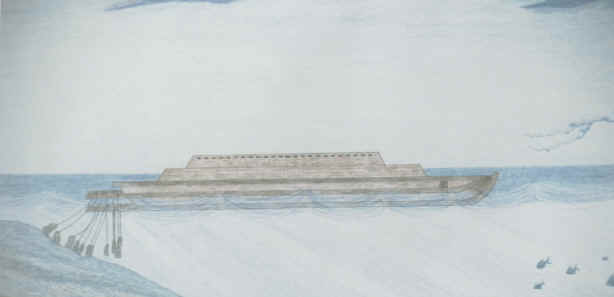
Table 4 yields the Ark relic's dimensions. Moses (educated in the Egyptian royal household) recorded its exact dimensions (using the 20.625- inch Egyptian cubit) as 300 cubits long by 50 cubits wide by 30 cubits high. It was longer than the six masted 329' USS Wyoming, the longest wooden ship built by modern man (or the legendary 400' Chinese Treasure Junk). The "Hebrew" cubit (which assumed different lengths at different times) wouldn't have come into use for many years after Genesis was written. Nevertheless, the NIV Bible still assumes the shorter Hebrew cubit (Genesis 6:15).
| Ark Parameter10 | Feet | Inches | Egyptian Cubits | |
|---|---|---|---|---|
| Length | 515.0' | 6180.5" +/-4" | 299.6 EC | |
| Maximum Beam (Computed) | 138.58' | 1663" +/-6" | 80.6 EC | |
| Average Width | 85.7' | 1029" +/- 6" | 49.88 EC | |
| Hull Depth (estimated) | 51' | 612" +/- 6" | 29.7 EC | |
| (Max. Beam Point) to Stern | 318' | 3819" +/- 6" | 185 EC | |
| (Max Beam Point) to Bow | 197' | 2361" +/- 6" | 144.5 EC | |
| Moon Pool Length | 201' | 2412" +/- 6" | 116.9 EC | |
| Moon Pool Width | 26' | 312" +/- 6" | 15.1 EC |
The bow seems to have draped or fallen forward to form a strip about 15 yards in front of the bow. This suggests that the minimum height of the hull was about 51' (implying a height of 29.7 cubits). Maybe this strip was originally miss- interpreted as forward beams required for supporting the anchor stones. Likely the stones were only deployed and operated through the Moon Pool (discussed later).
Windsor has done comprehensive analysis of the Ark relic and his tear drop
shaped hull is shown in Figure 17.8 Windsor's lofted (designed) is
fit to Fasold's hull outline. The Moon Pool is centered at the Ark's maximum
beam point, the exact location required to stabilize it. The Moon Pool's aft end
is reinforced with a triple row of iron fittings about 30" apart. This bulkhead
appears to be tripled suggesting that considerable strength was required in this
area. Two 4' or 5' foot wide iron masses are also found here and these are
suspected to be iron pipe-like posts for windlasses. Notice the presence of the
Moon Pool in Figure 17 and in Figure 6.
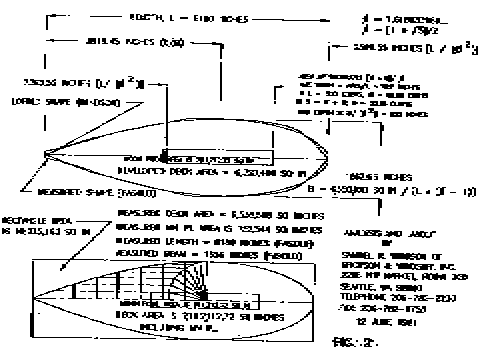
Figure 17. (click for displays) Windsor's 1992 rendition of Noah's Ark based on Fasold's Relic.8
The Moon Pool offers many attractive options to the design of the Ark.
Another cutaway view of the Ark is offered in Figure 18. This one differs from Windsor's solid reed hull design. It is more in line with the Geneses description of the Ark as having three decks but it is not consistent with the Gilgamesh description. Moreover, a loading door below the main deck offers a less "seaworthy" design. Further, the hull is more susceptible to collision damage. Figure 9 (the rib-slabs) suggests that extreme measures were taken to limit the Ark's vulnerability to collision damage.
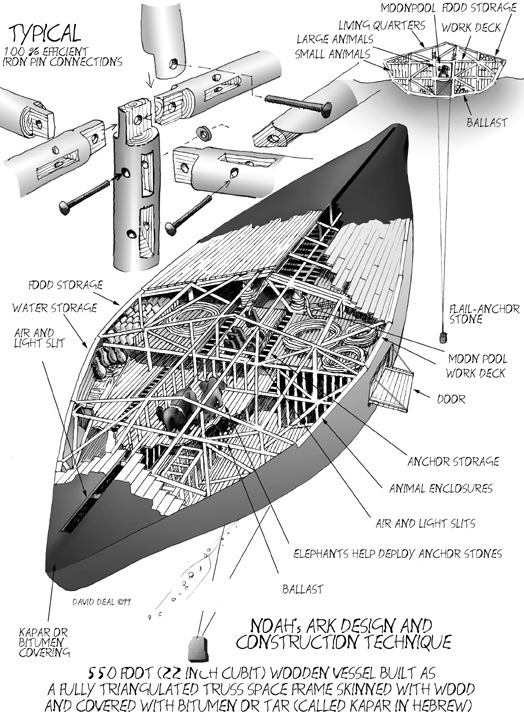
There is no clear indications of the superstructure or exactly how many
levels it had. Figure 18 suggests a superstructure-less Ark with a work-deck
located forward. It would more likely have been needed just aft of the Moon
Pool. The Ark was maneuvered through the use of the anchor and flailing
stone launched from this area. There is no evidence of a rudder, so this
area was extremely critical. The Ark had to be maneuvered in adverse currents by
skilled dragging of the anchors and by "flying" the flailing stone in
combination with the wind bearing against the entire structure. The "hole" in
the flailing anchor is about a third way down the stone. The anchor stones, on
the other hand, had a hole near the top with one side larger than the other
to prevent fraying or tearing of the rope. The flailing stone was used in
conjunction with an anchor stone, and in this way the Ark could be worked
cross wind (or maybe cross current). The reason was the necessity to pivot the
vessel about an anchor line. To some degree, the superstructure, or even the
hull itself, acted as a sail. This design would work only if the hull is
"shipshape" and not like a common barge. A box like Ark would rotate sideways,
heel over in a broadside wind, roll violently and possibly even capsize. The
long narrow back end of the Ark acts like the feathers on an arrow to point the
Ark in the desired direction. There is no evidence of sails or other propulsive
devices. The passengers of the Ark were in for a wild ride as the waters from
the tsunami (or tide) drained back into the Caspian Sea. The opportunity to find
a safe anchorage was a fleeting one. Missing that opportunity could mean that
the Ark and its passengers (and crew?) might hit a rock formation and capsize or
even sink. Figure 19 indicates that the joints are joined by seven rivets, not the
single one as shown in Figure 18.

The Epic OF Gilgamesh is another version of the Great Flood and was written around 2750 - 2500 BC. The Ark and Flood tale is largely confined to Tablet XI. But the first two tablets, Tablet I and Tablet II, loosely refer to an object from space, deemed a meteorite, that seems to be associated with this tale. These Tablets depict an alien presence with a strong aquatic association or presence. Utanapishtim (the Faraway) is postulated to be an extra-terrestrial (amphibian) alien (a Nommos). It would certainly be from "far away" as the Sirius star system is about eight light- years from Earth. Some of the "alien" related items found in Tablet I are listed in Appendix B and summarized in Table 6
Tablet XI tells of a six deck Ark with a 14400 (120 X 120) square cubit deck area. It contained 9 compartments (see Figure 6's transverse bulkheads). The Ark design was initially laid out (lofted) in a field where it was built of Kopher, not Gopher (which defies translation), wood, a wood coated with a tar like substance. See Appendix A. Metal (precious or otherwise) was loaded into it acting as ballast. There is no suggestion that this metal was slag (waste) but rather valuable material. The Ark was launched by rolling it on logs until it was two-thirds into the water. Windsor thinks it was built in a dry dock. The Nommos likely had the necessary earth-moving equipment (to build their own survival ponds).
A "rain of fire" from the comet's debris cloud was depicted in the Epic. The
tsunami (or tide) from the comet's impact washed over the dikes. Debris from
the comet impact clouded the air. The winds and waters raged, carrying the Ark
about in the resulting darkness. Civilization was washed away. The Ark wallows
then found an anchorage. Birds were released and found land. The flood-waters
drained away. Table 7 summarize these events and correlates them with
details from Tablet XI of the Epic Of Gilgamesh as documented in Appendix C. Joseph Smith identified Noah as "the angel Gabriel" who
in turn has been identified as an alien,
along with Utanapishtim and the Nommos.
Windsor
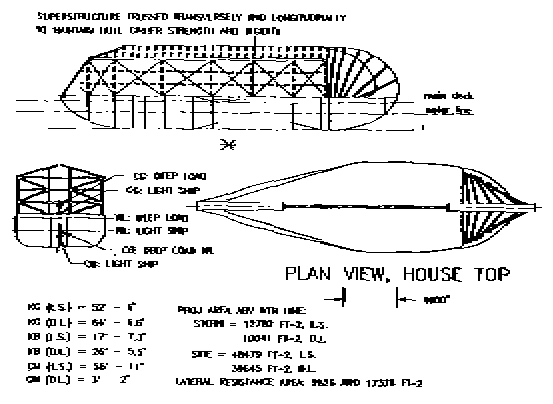
Windsor's Ark is has a 'solid' hull filled with reeds woven around logs. Apparently, the logs were stacked vertically near and joined with a framing structure about a cubit apart. The log may not have extend to the bottom of vessel. "The reeds appeared to be laid in sealing cementous material". The Ark's sides had to be protected from collision damage during its wild ride. The outer hull may not even have been 'planked over' and certainly was not water tight. Nevertheless, Windsor feels that some sort of vertical slabs made of 'something' were spaced along the hull's exterior to protect the soft reed bundles from contact stress damage. They might be made of "wood or they might have been cast from some sort of cementous material". The triple laminated bitumen covered 'plywood' shown in Figure 12 is possibly a good candidate. The massive gunnels (ribs) shown in Figure 9 were needed to hold this structure together and the reeds were used to soften the impacts from rock and debris the Ark struck along the way. The interior of the 'Moon Pool', which was used to pump air for the Ark's ventilation, may have been planked or sealed along the sides. Notice also that the Ark had no rudder to be likewise damaged, but was steered with rock hard 'flailing stones'. There is no evidence what these ropes were made of.
The superstructure depicted in Figures 16 and 17, was not based on any Ark recovery items. The Bible (Genesis 6:16 - Appendix A) indicates an Ark with three decks while the Epic Of Gilgamesh (Item 7 - Appendix C) specifies a six level Ark with seven decks. The top appears to contain an attic of about a cubit high. A three level hull (bottom, middle and top) could have appeared as the reeds decayed leaving layers of horizontally and vertically stacked log residue. These indications could have lasted till the time of Moses, 2,000 years later. Perhaps some of the superstructure could have been visible when the Epic was written, 500 to 700 years later. This could account for the two different reported levels. Windsor postulates no compartments, only bulkheads to separate the reed-woven log clusters. That means a solid Ark hull. However, Gilgamesh's reported compartments (Item 8 - Appendix C) indicates nine bulkheads which is consistent with the ground penetrating radar images (neglecting the Moon Pool). Gilgamesh may have imagined that the Moon Pool's bottom was covered to promote easy flotation, but Windsor feels this is unlikely. Windsor thinks that the Ark was ballasted before flotation.
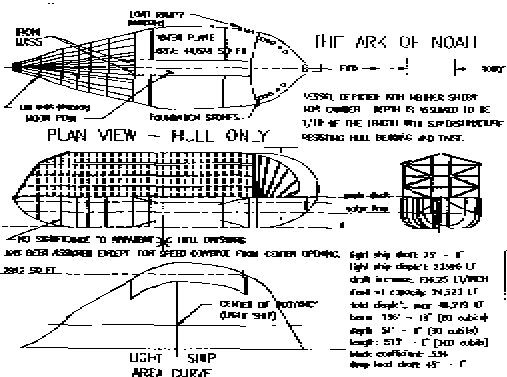
Figure 21 shows major structural items such as log ends and foundation stones
and the probable location of the loading ramp. The relic supports the Ark's
engineering items listed in Table 8.
TABLE 8
Structural Ark Related Items
- The presence, size and location of the Moon Pool indicates a very sophisticated design.
- The bow stem (on the front) curls back and over the fore deck.
- The stern (back end) terminates with a vertical log.
- Large "foundation stones" support structural members only at the bow front).
- Fossilized log ends (sediment circular layering) appear at several places along the sides (gunnels) and at the stern.
- Transverse bulkheads are found at each end of the Moon Pool. The aft end of the Moon Pool exhibits a triple row of iron fittings about 30" apart.
- Log ends are found outside (outboard) the sides (gunnels) except at two places believed to be near the loading port.
- The loading port is found about 45 yards from the front on the left (port) side.
- Apparently the loading port was left open after last used permitting a portal for mud to flood the inside of the Ark.
- 515.7' relic lenght/300 cubits biblical Ark length = 20.628"/cubits, close to 20.625" per Egyptian Cubit (EC).
- The ark is broad and stubby (300 EC - length, 79.7 EC - maximum beam).
- The depth is assumed to be about the reported 30 cubits (supported by the fallen bow stem).
- The Moon Pool is 114.6 EC long and 15.1 EC wide and center at the maximum beam point.
- Twelve of the anticipated twenty-four anchor stones have been found. Holes in the anchor stones are wider on one end, and of such size that the stones could be supported by a hand wound hemp rope with sufficient safety margin.
- One of the lighter anchor stones is a flailing stone, with a hole a located about a third of the way down its length.
- Bollards (posts possibly made of iron pipes whose remains are the 48" wide circular ferromagnetic signatures) were used as tie-downs to maneuver the Ark using a combination of anchor stones and flailing stones.
Windsor's analytical model suggests the end-point design requirements for the Ark as listed in Table 9. Notice that the light ship displacement is greater than a current British Harrier aircraft carrier (20,000 tons). It is more in line with the post WW II Hermes and Centaur class British aircraft carriers.
TABLE 9
Ark End Point Design Items
- Light Ship Draft - 25.75' (14.98 cubits)
- Max Load Draft - 45.08' (26.23 cubits)
- Light Ship Displacement - 23.596 long tons.
- Max Load Ship Displacement - 48,219 long tons
- Max Beam (at light load water line) - 136.83' (79.61 cubits)
- Length (at light load water line) - 513' (298.47 cubits)
- Light ship GM - 56.9' (33.11 cubits) Note: GM = metacentric height.
- Max Load GM - 3.17' (1.84 cubits) Note: GM = metacentric height.

The stability of a 80 cubit wide Ark is four times that of a 50 cubit wide Ark. The length to width ratio of 3.75 is a reasonable value for a "life-boat". The width to depth ratio of 2.7 is reasonable for a stable high center of gravity raft or barge.
The metacentric height (GM) is a measure of stability of a vessel. See Figure 18. It is the distance between an imaginary point about which the vessel rolls (called the metacenter) and the ship's center of gravity. It is the "lever arm" that keeps the vessel upright when it encounters an open ocean wave that can roll the vessel as much as 60o. Destroyers (length to breadth ratios of 9 or 10) were notably unstable during WW II. This was likely due to the pressure to add lots of top-side gear (like radars, dual purpose guns, etc.) Often, when listing during a turn they would only very slowly return to their proper upright position. The Ark was ten or eleven times more stable than a WW II battleship! The biblical recording of the heights of the waters above the mountains as only 15 cubits (Genesis 7:20) suggests that the Ark was lightly loaded (maybe with only Noah and his extended family and farm animals). Thus, the Ark's draft of 15 cubits was sufficient to permit it to remain afloat while the tsunami's (or tide) waters rushed over hazardous terrain. This "lightly loaded condition" is also consistent with the fear with which humans viewed the builders of the Ark (See the Book Of Noah 65.6 and 67.7). Humans then, as now, either feared the aliens and what they were doing or were deceived by their leaders. Comparative GM's (in feet) for modern ships are listed in Table 10.
TABLE 10
Ark Stability - Metacentric Height (GM)
- WW II Battleship - 5' or more
- WW II Cruiser - 3' or more
- WW II Destroyer - 1.5' - 2'
- Cargo Ship - 2'
- Noah's Ark – 57'
Windsor9 further concludes that the Ark's shape provided maneuverability, stability, low structural stress, good sea keeping characteristics, forced air ventilation (from wave motion in the Moon Pool) and an inboard refuse discharge area. While metal was used in its construction, long conductive paths from the roof to the sea were not present (providing shielding from lightening strikes). Apparently, he thinks the Ark could survive a 200 mph wind and 100 mph current. A comet strike would produce dramatic weather changes as well as powerful currents that could carry the Ark up into the mountains of Ararat. Massive turbulence would be encountered and potential compression damage could possibly have occurred as the Ark's bottoms and sides struck natural obstacles. The Ark was engineered to undertake a very wild ride. Windsor's analysis further suggests the Ark related standards listed in Table 11.
TABLE 11
Ark Related Measurement Standards
- The inch, not the cubit, was the measurement standard used in the design and lofting of the Ark.
- The "inch" is also found utilized in the Great Pyramid of Giza
- The inch is found on the "boss" (semi-circular 1.001" thick slab) found in the grand gallery.
- An ancient iron tool carbon dated to 3100 BCE also found in the pyramid.6
- The Ark's deck area
- The total area enclosed by the deck edge outline minus the moon pool's area or 7,112,113 - 761,713 = 6,350,400 inches2.
- Deck area from Genesis, 50 EC (1030") x 300 EC (6180") cubits = 6,365,400 inches2. Note: 20.625"/Egyption cubit (EC)
- Ark deck area from Gilgamesh is one "Iku", 120 GBC2 = 6,350,400 inch2. Note 21"/Great Babylonian cubits (GBC).
- One British acre = 44,100 feet2 = 6,350,400 inch2
- One British acre = one "Iku = (120 GBC)2 = 6,350,400 inch2
Notice that the measured Ark deck area almost precisely matches the "Iku" which has been handed down from the original Mesopotamia Epic Of Gilgamesh. "Iku" and "acre" even sound alike. Further, the old English inch equals 1.001 times the modern inch, and this value closely matches the "inch" thick boss found in the Great Pyramid of Giza. This connection between England and Mesopotamia is further strengthened by the observations of the author's of "Uriel's Machine".11 They claim that those who built the standing stones in sites such as Maes Howe in Orkney had extensive knowledge of mathematics and astronomy. They suggest that the ancient Scots knew of a threatening comet which would cause the Great Floods. This knowledge could have come from the Nommos. That ancient connection is still carried (in our collective conscience-ness) by the memory of the acre and inch.
Windsor also found that Fibonacci's Golden Ratio, phi, was used throughout the Ark's design. He was nbot
the only one. See this report from the Shabbat Shalom Family, dated: June 9, 2007
Description of Noahs Ark and the Length and width. What is a cubit? The Golden
section or Ratio
I have added a post in the forum section under the Heading of Noah's Ark 2007. In it, with the aid of the local Turkish news stories, I show you what was going on behind the scenes, as we traveled in Turkey, which I did not know of, until after we had left the Dugubayazit area. In this News Letter we will look at the measurements (the length and the width) of the boat shaped object. <Soon, everywhere I turned this strange number kept popping up. The 20.6 inch cubit times the 50 cubit width of the Ark was 1030 inches. If the angel's measuring reed was 6 cubits or 123.6 inches, this would be 10.3 feet! Yet the 123.6 inches of the reed was the 123.6 feet between bulkhead #9 and the very end of the Ark's bow extension. There must be a connection! The Ark seemed to be designed with some ratio in mind. This is apparent in the Holy Temple of Solomon as well, where the number 12 is important.
- The length of the Ark can be viewed as exactly fifty times the measuring reed, or pi, for 157.08 meters. When viewed in inch measure the resultant numerical series is phi, or 6180, more commonly known as the Golden Section
- First, consider that this ratio has increased the width of the Ark from 85.8 to 138 feet for a gain of 53 feet. This figure divided in half gives the center slot if 26.5 feet. I measured it at slightly over 26 feet, so we might assume this to be so. If we take 26.5 times 1.6180 we find it close to the distance measured between bulkheads #9 and #8. The correct figure should have been 42.877 feet. If we multiply this by three, we can calculate the next figure to be 128.631. I had measured it as 128 feet between bulkheads #8 an #7. Surely we are on to something here.
- would therefore suggest that the entire vessel is laid out by this ratio, that the bulkheads #6 is indeed the dividing point of the entire design, and that the portion to the forward end, 318.27 feet, times the 1.6180, give the vessels inside measure as 514.96 feet, again almost exactly 300 cubits.
Phi is such that if a line is divided into two parts, a & b, then the Table 12 relationships exist.
TABLE 12This Golden Ratio is used throughout the Ark's construction. Define y as its length, b as its maximum beam, m as the average beam width, d as its depth, and A as the circumscribed deck area (minus Moon Pool). M is the "deck area" of the Moon Pool and z & w is its length & width. Further, define MBP as the point along the length of the vessel where the maximum beam width occurs. Then MPB – S is the distance from this point to the stern and MPB – B is the distance to the bow. The MBP – S is the longest of these extensions (like a board protruding out of a structure), and thus the segment most susceptible to vibration. Windsor found the "phi" proportions in the Ark relic at least eight times.10 They have been reformulated in Table 13 to be linear in terms of phi because a linear relationship is thought to be fundamental to reducing vibrations in a vessel. Assume that the Ark's design criterion was to have the deck area of one acre and to take a 10,000" or 833' trough to crest non-broadside wave - at least one time (although Windsor has doubts about it surviving a high velocity tsunami). Then:
Phi Definition
- If a is the larger part "Phi" = a/b when a/b = (a + b)/a
- Phi, like "pi" (about 3.1416), is an irrational number.
- Phi = a/b = 1 + b/a = 1/2 x (1 + 51/2) = about 1.6180.
- The inverse of phi is phi-1 = b/a = a/b - 1 = about 0.618.
- Phi2 = phi + 1
- Phi-1 = phi - 1
TABLE 13
Phi In The Ark Structure (In Order Of Design Use?)
- Phi = 10,000"/y(Ark's length) = 0.618. Thus y = 10,000"/1.618 = 6180" = 299.6 EC
- Phi = m/d = A/(y x d). Thus, d = A/(y x phi) = 6,350,400 inch2/(6180" x 1.618) = 635" = 30.8 EC
- Phi = b/m = (b x y)/A. Thus, b = phi x A/y = 1.618 x 6,350,400 inch2/6180" = 1662.6" = 80.6 EC
- Since phi2 = phi + 1, then d x phi2 = d (b/m x m/d) = b = d x (phi + 1) = d x (m/d) + d = m + d
Thus m = b – d = 80.6 – 30.8 = 49.8 EC- Phi = y/(MBP-S). Thus (MBP-S) = y/phi = 6180"/1.618 = 3819.5" = 185.2 EC
- Phi = (y/z) – 1). Thus y/z = phi + 1 = phi2 or z = y/phi2 = 6180/1.6182 = 2360.6" = 114.5 EC
- Phi = mean hull length/mean Moon Pool length = (A/b)/(M/w).
Thus w = phi x b x M/A = 1.618 x 1663 x 752,544 inch2/ (6,350,400 inch2) = 319" = 15.5 EC
- Phi = (MBP-S)/(MBP-B) = 1.618. Because y = (MBP-S) + (MBP-B) then y/(MBP- S) = 1 + (MBP-B)/(MBP-S) or phi – 1 = phi-1 = (MBP-B)/(MBP-S)
- Length of Deckhouse (assumed) = b x phi2 = 210 EC. No mathematical or relic supporting data found.
Phi is a natural number that defines the structure of an ocean wave (and how the Ark would "ride" one). Windsor believes that including phi in the design some way reduces resonate vibrations that would tend to destroy the vessel. Note that the above phi relationships all involve linear ratios that could define an imaginary plate. Phi has very interesting properties related to the modes of vibration in thin plate structures and the frequency mixing (heterodyning) of electro-magnetic wave- forms as follows:
Further notice that the Figure 17 (Computer Estimated) Circumference Area
less the Moon Pool Area compared to the Designed Area (acre) is:
(7,112,112.72 inch2 - 752,544 inch2)/6,350,400
inch2 = 1.001
Thus, the measured deck area of the Ark met the designer's specifications, one
acre, and direct measurement of the Ark's parameters match the theoretical
values. See Table 14.
| Ark Parameter | Measured inches/(EC) | Theoretical inches (EC) | Bible |
|---|---|---|---|
| Length (Design Parameter) | 6180.5 +/- 4" (299.6) | 6180" (299.6 EC) | 300 EC |
| Hull Depth (estimated) | 612" (29.7 EC) | 635" (30.8 EC) | 30 EC |
| Maximum Beam (Extrapolated) | 1663" +/- 6" (80.6 EC) | 1662.6" (80.6 EC) | None |
| Average Width | 1029" +/- 6" (49.88 EC) | 1027.6" (49.82 EC) | 50 EC |
| (Max. Beam Point) to Stern | 3819" +/- 6" (185.2 EC) | 3819.5" (185.2 EC) | None |
| Moon Pool Length | 2412" +/- 6" (116.9 EC) | 2360.6" (114.5 EC | None |
| Moon Pool Width | 312" +/- 6" (15.1 EC) | 319" (15.5 EC) | None |
| (Max. Beam Point) to Stern/ (Max Beam Point) to Bow | 3819"
+/- 6" (185.2 EC)/ 2361" +/- 6" (144.5 EC) | 3819.5" (185.2
EC)/ 2361" (144.5 EC) | None None |
| Area (Design Parameter) | 6,359,568.72 inch2 | 6,350,400 inch2 | Table 11 |
The Ark's superstructure's shell is proposed to be a scaled down (9/10?) version of the Ark's shape, about 270 EC long and 27.7 EC high. This would provide a 58.5 EC hull girder modulus, close to the 60 EC Windsor assumed. Its cross section would still be much as Windsor suggests. The 01 and 02 -level decks would have similar Moon Pool like area (but reduced by about 10%) except that they would be split into four or more nominally equal-length segments. The top could have a similar reduced Moon Pool like open area, probably with a "roof". This design would offer a 3 - 4 EC wide walkway around the Ark so lines could be handled and hull/superstructure inspections made. It also would offer the same vibration resistant features as found in the Ark's hull.
The superstructure would end 47' or 27 EC before the stern and begin 3 EC before the bow. It major framing members would attach to the Ark's bulkheads depicted in Figure 6. The compression braced bow stem (possibly as much a 16 EC wide) would splay a large wave's impact and protect the superstructure's front if the Ark was pointed towards it. The force of the impact would be transferred through the entire Ark by the extended box girder structure of the Moon Pool as shown in Figure 6. If this wave were tsunami driven, the Ark would likely have to take the impact only one time.
The "Jewish Tales Of Ancient Times" offer an even more precise description of the Ark:
"150 chambers shall be the length of its right side, 150 chambers shall also be the length of its left; 33 chambers shall be its breadth at the front, 33 chambers shall also be its breadth at the back. In the middle shall be ten rooms for cooking utensils, also five store-rooms at the left side; there are to be pipes to bring water, (from the two large cylindrical tanks at the bow, 14' high and 24' across bound with metal bands) which can be opened and shut. The vessel shall be three stories high; as the first level is, so also shall be the second and third stories; in the lowest story are to be housed the cattle and wild animals; in the middle story shall nest the birds; the upper story is for men and the worm-creatures.12The above description can be fit to the relic accordingly. The living spaces would be around the ventilation provided by the Moon Pool. This is its 117 EC length and a roughly semi-circular bow region with a nominal radius of 36 EC. Two rows of 25 chambers, each about 7 EC wide (with about 0.4 EC more for framing), are postulated with a ventilation strip along the middle of the mutual walkway on the 01 and 02 decks. The walkways would be about 4 EC wide with a 4 EC strip running down the middle between them. An 8 EC walkway around the Moon Pool is anticipated for line handling and refuse dumping. The main deck chambers would only have a 4 EC walkway separating them. The chambers would be about 10 EC deep. The front 11 chambers (per story) would be along the curved bow and about 76 cubits long. Living area near the Moon Pool was prime real estate on the Ark. The best quarters were "topside". The five storage aft rooms would be formed from vertical extensions of the bulkheads aft of the Moon Pool. The existence of the described aft chambers is questionable as the aft end of the Moon Pool may be needed to ventilate the store-room and they would be poorly ventilated. The middle ten rooms (per story?) would be above the Moon Pool (maybe on the 02 and 03 decks) and the cooking fires vented directly upwards. The anchor and flailing stones could be handled from mountings attached to the 01 deck. The worm-creatures refer to above are the amphibious aliens (Nommos) who would "man" the Ark using skills from home. They could also communicate with their air and space born craft tracking the Ark's progress and offer navigational direction during its wild ride.
The Nommos See Table H-13 here offer a viable image of the worm-creatures from Sirius.13
Babylonian Ark Stories were recorded by the Greek historian Berosus (4th century BC).
"To him [Xisuthrus] the deity Cronus deity (the alien - Utanapishtim (the Faraway)) foretold that on the fifteenth day of the month Desius there would be a deluge of rain ... after the cessation of the rain Xisuthrus sent out birds, by way of experiment, that he might judge whether the flood had subsided. But the birds passing over an unbounded sea, without finding any place of rest, returned again to Xisuthrus. This he repeated with other birds. And when upon the third trial he succeeded, for the birds then returned with their feet stained with mud, the gods translated him from among men. With respect to the vessel, which yet remains in Armenia, it is a custom of the inhabitants to form bracelets and amulets of its wood."
ET Aliens Archangels(like Gabriel) instructs that the Ark be made of reeds and covered with pitch. Also, it is provided a form of artificial light in the Ark.14
This light giving stone correlates with the 16 "shining stones" used by the Jews in crossing over to South America circa 600 BC. And they also can be correlated with the technology found in the "Time Capsule Of Alien(?) Technology" considered in Appendix D. Open fires on the pitch coated wooden Ark would have to be carefully contained. A single "great pearl" would have been inadequate to light such a massive and intricate vessel as the Ark appears to be. However, 16 or more such lights could have provided the necessary lighting. It is proposed that the 16 shining stones recovered from the Ark relic were lights.
The Ark may have housed six (or more) per chamber, totaling almost 2,000. Gilgamesh was a "king" and gave away his palace before the deluge. The ET aliens may have been surprised when so few showed up along with farm animals. The Naval Observatory, Los Alamos National Laboratories and the CIA(Temple15) aggressively suppressed the Ark find, the Sirius Mystery and the IRAS point (Vulcan or Planet X) association. A Rand scientist suggests secrecy should there be an impending impact. Meanwhile the US Government works on its "Continuity Of Government" shelters.
The boat shaped formation examined by Windsor and Fasold appears to have had
sea keeping features appropriate for its mission of riding out a massive flood
from a comet or meteorite strike. While some may argue that it is just a
natural formation of "dirt, iron and rock", it is highly unlikely that all the
reported historical information could be generated by a natural structure.
Specifically:
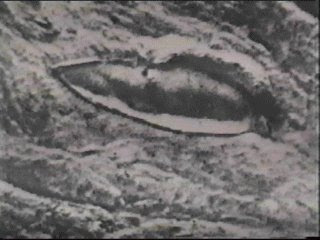
Other evidence suggests that there was alien activity on Earth around and after the time of Noah. Other than Noah's Ark, there are two other ancient artifacts exhibiting alien technology. The most obvious is the Great Pyramid, the world's largest building and, at the start of the 20 thcentury, the tallest. So perfect is it that it could not be reproduced today. Both Pi (3.14159...) and the phi (The Golden Ratio) are found woven into its design. The Great Pyramid's four sides are concaved (dimpled) and it is actually an eight-sided pyramid. The question of how the pyramid was built (or why it is concave) has never received a wholly satisfactory answer. See Figure 24.
This concavity divides each of the apparent four sides in half, creating a very special and unusual eight-sided pyramid; and it is executed to such an extraordinary degree of precision as to enter the realm of the uncanny. For, viewed from any ground position or distance, this concavity is quite invisible to the naked eye. The hollowing-in can be noticed only from the air, and only on the equinoxes. This explains why virtually every available photograph of the Great Pyramid does not show the hollowing-in phenomenon, and why the concavity was never discovered until the age of aviation. It was discovered quite by accident in 1940, when a British Air Force pilot, P. Groves, was flying over the pyramid. He happened to notice the concavity and captured it in the now-famous photograph.
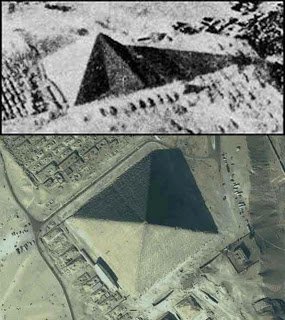
Additionally, no one knows how anyone of that day could have been reasonably built this structure. But the alien presence adds a whole different dimension to this problem. The amount of building material used for constructing the Great Pyramid was monumental by itself.
The Great Pyramid consists of an estimated 2.3 million blocks which most believe to have been transported from nearby quarries. The Tura limestone used for the casing was quarried across the river. The largest granite stones in the pyramid, found in the "King's" chamber, weigh 25 to 80 tonnes and were transported from Aswan, more than 800 km (500 mi) away. Traditionally, ancient Egyptians cut stone blocks by hammering into them some wooden wedges, which were then soaked with water. As the water was absorbed, the wedges expanded, causing the rock to crack. Once they were cut, they were carried by boat either up or down the Nile River to the pyramid.[18] It is estimated that 5.5 million tonnes of limestone, 8,000 tonnes of granite (imported from Aswan) , and 500,000 tonnes of mortar were used in the construction of the Great PyramidMany alternative, often contradictory, theories have been proposed regarding the pyramid's construction techniques. One was that it was built by about 100,000 men over a time span of 20 years. Does that really sound even reasonable?
Given the presence of ET aliens, especially the Nommos, an Artisan Sentient species, it seems more reasonable that they built the Great Pyramid. Sirius, the Nommos home star system, is also used in the yearly initiation of the Egyptian lunar calendar. Their antigravity equipped saucers, similar to those of the Iargans, could easily transport and accurately place these gigantic stones from hundreds of miles away (even though much of this was along the Nile river).
After the Great Flood of 3195 BC, Egypt languished. About 3025 BC, Egypt's first kings appeared, then the first dynasty appeared over 2925 to 2575 BC. The Great Pyramid and the Great Sphinx of Giza were built during Cheops reign in the fourth dynasty, between 2575 and 2465 although radiocarbon evidence dates it to about 200 or 400 years earlier. However, the southern shafts in the kings chamber align with Sirius in 2500 BC. The Nommos (ET Aliens) home star is in the Sirius star system. They are a species of amphibians, use to water travel (in ships) and perhaps weaving reeds.
This is about the time the famous Akkadian seal appeared showing our solar system. The Akkadian Seal depicts Vulcan (AKA Nibiru) as well as known planets.

Figure 26 shows that effectively, the mass of the Jovian planets relative to the Sun were depicted on this seal in a logarithmic manner.
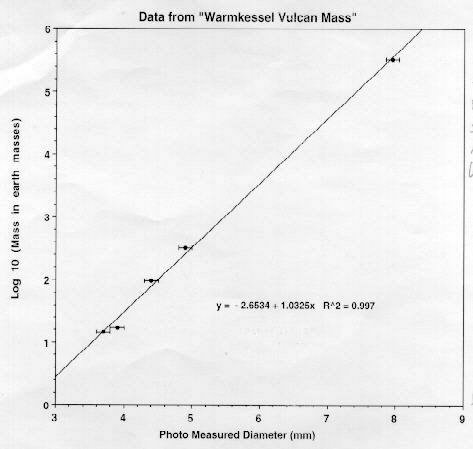
Vulcan drags comets from the Kuiper belt into an orbit passing near Earth and an impact from one caused the Great Flood. Vulcan is estimated to be of 22nd magnitude or more. The Akkadians could not detect it but it is reasonable that Nommos aliens could. They may have explained its significance after the Great Flood as recorded on the seal depicted in Figure 25. Further, is it logical that humans would not have the technology discovered in the Ark relic but it is logical to attribute it to alien sources. Thus, the Ark relic indirectly confirms Vulcan's existence and that directly leads to Earth impacts that may have caused several biblical catastrophes.
It is rumored that Noah's Ark was built in Iraq. The Akkadian civilization was active there, and one would expect those in the US government, greedy for ET alien technology, would want those treasures. Sure enough, war soon broke out and the USA invaded a country that had never attacked it, Iraq. Some did suspect that it more about ET alien technology than about oil. There are lots of other oil rich countries, so that would hardly be an issue.
Even more compelling (alien?) technology is found in the Cave Of The Ancient's (Appendix D). It contains models of cities, moveable gear and long duration lighting as well as thought generating picture machines. The witness (T. Lobsang Rampa) associates this with a "Sphinx". He and his lamaist monks friends undertook a "remote viewing" exercise and came up with a story very consistent with the one of the Great Flood (as being an impact event). See Appendix E. The accompanying meteorite shower and flood are "viewed" along with the horror of the event. The book was published circa 1963, and the experience happened long before that, when "catastrophism" or "aliens" were not popular subjects.
There are three major implications associated with the Ark relic, and they are meaningful to us today. The First Major Implication, and probably the one of most value, is that the Ark relic verifies the various legends found in Genesis, the Epic Of Gilgaesh and various other flood tales. But more importantly, it verifies the words of Christ. Christ is an Avatar Of The Infinite Soul, for example similar to Buddha as can be mathematically demonstrated. Objects orbiting the Sun have to move about in an Orbit plane, so points supporting that orbit must be co-planer which is what was found. These Avatars have access to all knowledge and Christ recognized Noah's Flood (Matthew 24: 37 - 39) and by extension, Noah's Ark. Noah's Flood and his Ark are not a fairy tale. It was a very real event.
Windsor asks "Was this the vessel built by Noah, and if not, who did build it?". That is a very good question, and it brings us to the relic's Second Major Implication. It appears that Noah's Ark is a relic of alien design and probably construction. ET aliens are the angels found throughout the Bible. Perhaps Noah's Ark should be referred to as The Nommos' Ark. This conclusion is supported by the following observations:
Items eight through ten indicate the use of advanced metallurgy. Additionally, an iron tool found in the Great Pyramid has been radiocarbon dated to about the time of the Ark's construction, 3100 BC. The Naval Observatory (and even the CIA) appear to be involved in the suppression of both the Sirius Mysery and Planet X - IRAS point discovery. Los Alamos National Laboratories knew of the Ark's titanium, and quickly moved to suppress its discovery. The Ark relic is the "smoking gun" that implicates the U.S. government in both the UFO cover- up and another to suppress knowledge of frequent dangerous comet strikes. Such a strike could cause the death of billions .
Items eleven through thirteen indicate the Ark's builders used modern ship- building techniques. The Samarians were a culture that had just discovered the wheeled vehicle. How then could they know about lofting techniques that used ellipses and parabolas? Items fourteen and fifteen deal with the extensive use of the Golden Ratio "phi" in the Ark's design. This alien technique stimulates two separate vibration modes that can be independently suppressed. It is a new alien technology that should be further investigated and could be applied to modern aircraft and naval vessels.
The Third Major Implication is "Why would aliens travel light-years between the stars to help human beings"? It is doubtful that we could offer a new source of food or labor for such an advanced race. Our raw materials are much farther away then those likely available in their own solar system. Two "spiritual" consequences, reflecting on actions found in the physical universe, are postulated to be the reason. The first is a "Philanthropic karmic debt", one just the opposite of a negative one gained by those suppressing knowledge of the dangerous comet swarms. By saving humanity, the favor would be returned to their species. Humans, a warrior species, would act to save them. Having a Warrior species around on one's side when trouble comes could prove beneficial.
The inch and the acre (Iku) unit of measure are found in the (Christian) cultures of England and the USA. This is a clue as to what drove the Nommos to go such great lengths to save the humanity. Noah's story is common to Christianity, Islam and Judaism. The former two are large religions, driven by the manifestation of an avatar. Avatars form a "club". The memory of their existence in human culture is treasured. The Dogon legends imply that the Nommos were involved with an avatar of their own species. Technically, avatars are shared by a set of seven sentient species (a Combo) so it was likely one known by humans. Perhaps mankind's infinite or transcendental soul (e.g. Christ or Mohammed) also "manifested" with the Nommos. Perhaps in such a manifestation, one or both of them were reaching out to save mankind from a catastrophic comet impact. Certainly, Christ (Revelation 8 and 9) was reaching out to us with just such a comet or meteorite impact warning.
The Nommos were likely the origin of our tales of mermaids and mermen. However, it is unlikely that the Nommos' avatar accompanied them to Earth. A species intelligent enough for space travel would likely not risk the "life" of their avatar on such a sojourn. Avatars are just too valuable. In fact, they are more valuable then the entire incarnate sentient species because they impact its evolution in such a positive manner. Truly, they are the "light of our lives". This is why "religions" form around them, irregardless of how poorly the religion interpreters the impact of their manifestation.
Returning to the First Major Implication, since Christ's words about Noah's Flood have been scientifically verified, perhaps his other words also warrant sincere scientific evaluation. The Bible is full of warnings of comet or asteroid impacts, especially from Christ as found in the New Testament. For example, A retired Nuclear Physicist & Engineer, who worked U.S. Department of the Navy, has interpreted Christ's warnings as follows:
Astronomers keep insisting that comet impacts with Earth are rare. However, if the brown dwarf object called 'Vulcan' herein exists, such cosmic impacts would be frequent, and this is what is found. Furthermore, what about Christ curing people (Mark 6:5) with a mere touch? That would be a neat trick to have available and He did also say:"Starting at the end and work forwards, the last Cataclysmic event is when the Earth is renovated by fire. It is discussed in 2 Peter 3:5-13 and Revelation 20:7-15. The Earth is turned into a sea of fire and lava. There are no longer any oceans. This event could be cause by a large impactor 100- 200 miles in diameter.
Before that happens there will be a millennium, a thousand years, of peace. Revelation 20:1-6 - God made a promise to the Jewish people, during this time he will begin to fulfill it. Before that there is a Great Tribulation. This event is discussed in Matthew 24:21, Revelation 8:5-13, Revelation 6:12-17, Revelation 16:17-21 and Revelation 18:8-10,21 to name a few. The damage falls in line with the damage that would be created from an impactor in the 2-3 mile diameter range. Across many cultures, dragons have been symbolic of comets. As a result, if the damage during the Great Tribulation, was done by an impactor, it is somewhat natural to believe that the impactor would be a comet."
(John 14:12) Very truly I tell you, whoever believes in me will do the works I have been doing, and they will do even greater things than these, because I am going to the Father.Maybe we can do likewise. Its sure worth a scientific investigation.
Infinite Soul Avatars are everybody's essence twin. They exert a powerful influence on any sentient species into when they manifest. Hans Christian Andersen and Ryborg Voigt were Essence Twins ( In Ballad, Stories Or Fact). It is both interesting and significant that one of Andersen's most famous tales is "The little Mermaid". A similar circumstance is found with the Great Pyramid of Giza. The "inch" and the "golden ratio" are common to both the Ark relic and the Great Pyramid. Ed Leedskalnin (1887 - 1951) built the Coral Castle near Homestead, Florida for his essence twin Anges (his "Sweet Sixteen"). He moved up to 30-ton blocks of coral by himself, claiming to know the secret of how the pyramids were built. The implication from both the mathematical values and the coral castle suggests that an avatar of the Infinite Soul motivated the Nommos to travel to Earth and build the Ark. To the survivors of the Great Flood, these would truly be regarded as 'angels'.
Noah's Ark has been found numerous times, from the time of Moses, to the time of Josephus to the time of the Crusaders to the present. Fasold found it recently by using geographical triangulation techniques specified by the ancients. Indications that this is the Ark are supported by fossilized material, metallurgy and structural marine engineering results that match recorded historical legends.
The Ark appears to be a solid-hulled reed-raft 300 Egyptian cubits long with a maximum beam of 80 cubits (the hollow hull vessel depicted in Figure 18 would likely have been breached by collision damage during its wild ride). The 30- cubit depth is indicated by part of the bow that has collapsed and by discovered structural design that would resist sagging and hogging. It apparently had a light water displacement of about 23,600 long tons and a draft of about 15 cubits. The Ark appears to have been lightly loaded, not utilizing most of the 24,000 tons it could have carried. The Ark is far too complex to have been engineered and built by humans of the time. A stabilizing rectangular Moon Pool along the Ark's center-line is one such example. Further, the Ark's metallurgy reveals iron (not generally available until 2,000 years later) and other metals that were not available until the 20th century.
The Ark may have been built by the Nommos, our Artisan co-sentient Combo alien species who relish building things. These extraterrestrial alien amphibians would likely have a considerable background in marine engineering and construction of nautical vessels. They may also have been familiar with the structural engineering properties provided by "reeds". They are reported to have arrived from the Sirius star system in time correlation with Noah's Flood. They are believed to have provided the humans of the day with knowledge of our solar system, the Sirius star system and at least one example of a major meteorite impact forming a large lake. Cuneiform writing and wheeled vehicles may have been the "alien technology" of that day. Like today, the aliens considered humans to be "deceptive". Their leaders may not have told others of the impending catastrophe and that may be why so few saved.
Five comet swarms are believed to be generated by our Sun's unlit companion star. One is predicted to have pass through the inner solar system in 3078 BC but may have actually passed by around 3195 BC. The Nommos arrived in time correlation with the passage of the swarm. It appears that they had enough knowledge of the trajectories of the threatening comets that they could predict the time and location of a dangerous strike. Multiple impacts are believed to have caused tsunamis or super-tides (or both), two of which were the source of Noah's Flood. The timeline is as follows.
The Nommos may have been motivated to save humanity by an avatar, possibly one like Christ, Buddha, etc. This avatar would have assumed their body type. It is not unreasonable that such an avatar may soon once again influence the events happening on planet Earth.
1. Different translations of the Bible translate the wood used in the
construction of the Ark variously as: Gopher wood in the King James Version,
Cypress wood in the New International Version, etc. Matt Slick (at his
excellent apologetics website: Christian Apologetics and Research Ministry)
presents a fascinating discussion of this matter which is worth looking into
further. Quite simply, he raises the point that Gopher wood may not have been
wood from a specific tree, such as Oak or Maple, as much as it was wood of a
specific style, such as Plywood or Particle Board. Instead of being solid
timbers from a specific tree
Gopher wood may actually have been a laminate
of some type. Laminated wood is used today as an inexpensive yet strong
construction material, plywood is used frequently as subfloor and roof sheeting
in the construction of our homes. If this is true then the strength of the Ark
would have been tremendous since a laminated beam is much stronger than a solid
beam of the same dimension. But a more likely translation is the following:
"Gopher wood" is a misreading and scribal error. "Kopher" wood
is correct and means wood (any wood) that is covered with Kopher. Kopher is
bitumen. In the Genesis text (6:14), the context is clear. The GPR wood used, (a
scribal error) is to be covered in KPR. G and K in Hebrew are so similar that
inexperienced Hebrew "scholars," such as those translating the King James
Version of the Bible, could have been prone to such errors.

2. Regarding the preservation of the wood over the 100 year long construction period we know that God told Noah to coat the Ark with pitch or resin. This material is a natural preservative and would be sufficient to ensure the preservation of the Ark during the 100 years or so that Noah and his sons were building the Ark. If a "year" and a "month" time periods were confused, construction of the Ark over a nominal 8 or 9 year period would be a reasonable number of years for such a project. Windsor points to previous reed raft construction techniques suggested that the reeds had to be cut and woven into the reed raft within a single year or season.
3. It is supposed that Noah and his sons took 100 years to build the Ark. This number is arrived at quite simply by subtracting the age of Noah when we first hear of him (500 years old at the birth of Shem, Ham, and Japheth) from the age of Noah when he entered the Ark (600 years) and is based on the assumption that Moses, in compiling Genesis, would have utilized documents written by those concerned. Moses therefore incorporated Noah's personal journal into the work that bears his name. Luke followed a similar process when he compiled the Gospel of Luke and the book of Acts in the New Testament. If Moses truly did make use of Noah's journal then it stands to reason that the first time a year is given in Noah's case represents his age when he began to build the Ark.
4. The 120 years mentioned early in Genesis 6 seems to indicate the maximum number of years which God would permit humans to live in the post flood world. This was the age to which Noah lived and is in keeping with the sudden and dramatic decline in life span after the flood. The Epic OF Gilgamesh considered in the next appendix discusses a medicine or elixir that possibly was to be provided by the "alien". Perhaps Noah was only 40 at the beginning of the Ark's construction. Assuming an eight or nine year construction period, he would be around 50 at the initiation of the flood. Gilgamesh (AKA Noah) lost the medicine, thus leading to the long life/short life interpretation of this material.
5. Of the total vertical height of the Ark there is good reason to believe that 15 cubits of it was submerged (Genesis 7:20 records that the depth to which the mountains were submerged was at least 15 cubits thereby implying that the draught of the Ark itself was no greater than this figure). This seems a reasonable presumption given the structural considerations offered herein. The inertia of the super-tide or tsunami could have been such that the water rushed up and down hills and mountains, and its depth would have been variable.
6. The Chinese character for ship (as in a large vessel) is formed from the
character for a small boat plus the character for eight and the character for
mouth (implying a person).

Tablet I and Tablet II from the Epic of Gilgamesh both refer to a "meteorite" or a celestial object which fell from the sky and was related to the God Anu. The implication is that the meteorite represents a space ship or flying saucer. Notice the aquatic reference to a "might trapper" who releases animals from the traps set for them. Following are some examples from Tablet I.
Preliminary analysis of the Ark's structure permits us to understand the Epic Of Gilgamesh in a clearer light. Tablet XI The Story of the Flood is documented below. The comments relating the Epic to the Ark and the thesis of this web site that it was built by an alien species are in italics.
A group of lamaist monks are lead a cave which is the repository (Time Capsule) of ancient technology (machines, lifts, artificial lights similar to the one described used on the Ark and others) as well as models of cities (alien or human?). While this cache exists in Tibet, others are said to exist in Siberia, South America (under or near a pyramid) and in Egypt. A sphinx is sometimes associated with them thereby implying that they were formed within a few centuries of 3000 BC. Images from thought-picture machines were offered that implied UFOs or flying saucers as well as cities and bridges being destroyed by bombs or meteorite strikes. Diatribes of leaders calling for war was presented, sounding unnervingly like today. A mixture of human actions and alien artifacts may be involved and these have not been effectively separated.23 It has been suggested that the possible incursion of the USA's military forces into Iraq, where ancient Samaria is located, is for just such technologies. After all, the US intervention in Granada may have been to silence its calls for UN investigation of the UFO phenomena.
I looked in considerable astonishment. At first I could not see the entrance, all I saw was a dark shadow looking much like a dried-up watercourse, or the stain of minute lichen. Then, as we crossed the ledge, I saw that there was indeed a crack in the rock face. A big lama grabbed me by the shoulders and pushed me into the rock fissure saying, good-naturedly, "You go first, and then you can chase out any rock devils and so protect us!" So I, the smallest and least important of the party, was the first to enter the Cave of the Ancients. I edged inside, and crept round the rock corners. Behind me I heard the shuffle and scrape as the bulkier men felt their way in. Suddenly the light burst upon me, for the moment almost paralyzing me with fright. I stood motionless by the rocky wall, gazing at the fantastic scene within. The Cave appeared to be about twice as large as the interior of the Great Cathedral of Lhasa. Unlike that Cathedral, which always was enshrouded in the dusk which butter lamps tried vainly to dispel, here was brightness more intense than that of the full moon on a cloudless night. No, it was much brighter than that; the quality of the light must have given me the impression of moonlight. I gazed upwards at the globes which provided the illumination. The lamas crowded in beside me, and, like me, they gazed at the source of light first. My Guide said, "The old records indicate that the illumination here was originally much brighter, these lamps are burning low with the passage of hundreds of centuries."
For long moments we stood still, silent, as though afraid of waking those who slept throughout the endless years. Then, moved by a common impulse, we walked across the solid stone floor to the first machine standing dormant before us. We crowded around it, half afraid to touch it yet very curious as to what it could be. It was dulled with age, yet it appeared ready for instant use - if one knew what it was for and how to operate it. Other devices engaged our attention, also without result. These machines were far, far too advanced for us. I wandered off to where a small square platform about three feet wide, with guard rails, rested on the ground. What appeared to be a long, folded metal tube extended from a nearby machine, and the platform was attached to the other end of the tube. Idly I stepped on to the railed square, wondering what it could be. The next instant I almost died of shock; the platform gave a little tremor and rose high into the air. I was so frightened that I clung in desperation to the rails.
Below me the six lamas gazed upwards in consternation. The tube had unfolded and was swinging the platform straight to one of the spheres of light. In desperation I looked over the side. Already I was some thirty feet in the air, and rising. My fear was that the source of light would burn me to a crisp, like a moth in the flame of a butter lamp. There was a "click" and the platform stopped. Inches from my face the light glowed. Timidly I stretched out my hand-and the whole sphere was as cold as ice. By now I had regained my composure somewhat, and I gazed about me. Then a chilling thought struck me; how was I going to get down? I jumped from side to side, trying to work out a way of escape, but there appeared to be none. I tried to reach the long tube, hoping to climb down, but it was too far away. Just when I was becoming desperate, there was another tremor, and the platform started to descend. Hardly waiting for it to touch ground I leaped out! I was taking no risks that the thing would go up again.
Against a far wall crouched a great statue, one that sent a shiver up my spine. It was of a crouching cat body, but with the head and shoulders of a woman. The eyes appeared to be alive; the face had a half-mocking, half-quizzical expression which rather frightened me. One of the lamas was on his knees on the floor, gazing intently at some strange marks. "Look!" he called, "this picture writing shows men and cats talking, it shows what is obviously the soul leaving a body and wandering in the under-world." He was consumed with scientific zeal, poring over the pictures on the floor – "hieroglyphs" he called them-and expecting everyone else to be similarly enthused. This Lama was a highly trained man, one who learned ancient languages without any difficulties at all. The others were poking around the strange machines, trying to decide what they were for. A sudden shout made us wheel round in some alarm. The tall thin Lama was at the far wall and he seemed to have his face stuck in a dull metal box. He stood there with his head bent and the whole of his face concealed. Two men rushed to him and dragged him away from the danger. He uttered a roar of wrath and dashed back!
"Strange!" I thought, "even the sedate, learned lamas are going crazy in this place!" Then the tall, thin one moved aside and another took his place. So far as I could gather, they were seeing moving machines in that box. At last my Guide took pity on me and lifted me up to what apparently were "eye pieces." As I was lifted up and put my hands on a handle as instructed, I saw inside the box, men, and the machines which were in this Hall. The men were operating the machines. I saw that the platform upon which I had ascended to the light-sphere could be controlled and was a type of moveable "ladder" or rather a device which would dispense with ladders. Most of the machines here, I observed, were actual working models such as, in later years, I was to see in Science Museums throughout the world.
We moved to the panel which the Lama Mingyar Dondup had told me about previously, and at our approach it opened with a grating creak, so loud in the silence of the place that I think we all jumped with alarm. Inside was the darkness, profound, almost as if we had clouds of blackness swirling about us. Our feet were guided by shallow channels in the floor. We shuffled along, and when the channels ended we sat. As we did so, there came a series of clicks, like metal scraping against metal, and almost imperceptibly light stole across the darkness and pushed it aside. We looked about us and saw more machines, strange machines. There were statues here, and pictures carved in metal. Before we had time to more than glance, the light drew in upon itself and formed a glowing globe in the center of the Hall. Colors flickered aimlessly, and bands of light without apparent meaning swirled round the globe. Pictures formed, at first bluffed and indistinct, then growing vivid and real and with three dimensional effect. We watched intently ...
This was the world of long, long Ago. When the world was very young. Mountains stood where now there are seas, and the pleasant seaside resorts are now mountain tops. The weather was warmer and strange creatures roamed afield. This was a world of scientific progress. Strange machines rolled along, flew inches from the surface of the Earth, or flew miles up in the air. Great temples reared their pinnacles skywards, as if in challenge to the clouds. Animals and Man talked telepathically together. But all was not bliss; politicians fought against politicians. The world was a divided camp in which each side coveted the lands of the other. Suspicion and fear were the clouds under which the ordinary man lived. Priests of both sides proclaimed that they alone were the favored of the gods. In the pictures before us we saw ranting priests-as now purveying their own brand of salvation. At a price! Priests of each sect taught that it was a "holy duty" to kill The enemy. Almost in the same breath they preached that mankind throughout the world were brothers. The illogicality of brother killing brother did not occur to them.
We saw great wars fought, with most of the casualties being civilians. The armed forces, behind their armour, were mostly safe. The aged, the women and children, those who did not fight, were the ones to suffer. We saw glimpses of scientists working in laboratories, working to produce even deadlier weapons, working to produce bigger and better bugs to drop on the enemy. One sequence of pictures showed a group of thoughtful men planning what they termed a "Time Capsule" (what we called "The Cave of the Ancients"), wherein they could store for later generations working models of their machines and a complete, pictorial record of their culture and lack of it. Immense machines excavated the living rock. Hordes of men installed the models and the machines. We saw the coldlight spheres hoisted in place, inert radio-active substances giving off light for millions of years. Inert in that it could not harm humans, active in that the light would continue almost until the end of Time itself.
We found that we could understand the language, then the explanation was shown, that we were obtaining the "speech" telepathically. Chambers such as this, or "Time Capsules," were concealed beneath the sands of Egypt, beneath a pyramid in South America, and at a certain spot in Siberia. Each place was marked by the symbol of the times; the Sphinx. We saw the great statues of the Sphinx, which did not originate in Egypt, and we received an explanation of its form. Man and animals talked and worked together in those far-off days. The cat was the most perfect animal for power and intelligence. Man himself is an animal, so the Ancients made a figure of a large cat body to indicate power and endurance, and upon the body they put the breasts and head of a woman. The head was to indicate human intelligence and reason, while the breasts indicated that Man and Animal could draw spiritual and mental nourishment each for the other. That Symbol was then as common as are Statues of Buddha, or the Star of David, or the Crucifix at the present day.
We saw oceans with great floating cities which moved from land to land. In the sky floated equally large craft which moved without sound. Which could hover, and almost instantly flash into stupendous speed. On the surface vehicles moved some inches above the ground itself, supported in the air by some method which we could not determine. Bridges stretched across the cities carrying on slender cables what appeared to be roadways. As we watched we saw a vivid flash in the sky, and one of the largest bridges collapsed into a tangle of girders and cables. Another flash, and most of the city itself vanished into incandescent gas. Above the ruins towered a strangely evil-looking red cloud, roughly in the shape of a mushroom miles high.
Our pictures faded, and we saw again the group of men who had planned the "Time Capsules." They had decided that now was the time to seal them. We saw the ceremonies, we saw the "stored memories" being fitted into the machine. We heard the speech of farewell which told us-"The People of the Future, if there be any!"-that Mankind was about to destroy itself, or such seemed probable, "and within these vaults are stored such records of our achievements and follies as may benefit those of a future race who have the intelligence to discover it, and having discovered it, be able to understand it." The telepathic voice faded out, the picture screen turned black. We sat in silence, stupefied by what we had seen. Later, as we sat, the light grew again and we saw that it was actually coming from the walls of that room.
We rose and looked about us. This Hall was also littered with machines and there were many models of cities and bridges, all formed of some kind of stone or of some type of metal the nature of which we were unable to determine. Certain of the exhibits were protected by some quite transparent material which baffled us. It was not glass; we just did not know what the stuff was, all we knew was that it effectively prevented us from touching some of the models. Suddenly we all jumped; a baleful red eye was watching us, winking at us. I was prepared to run for it when my Guide the Lama Mingyar Dondup strode over to the machine with the red eye. He looked down at it and touched the handles. The red eye vanished. instead on a small screen we saw a picture of another room leading from the Main Hall. Into our brains came a message, "As you leave, go to the room (???) where you will find materials with which to seal any opening through which you entered. If you have not reached the stage of evolution where you can work our machines, seal this place and leave it intact for those who will come later."
Silently we filed out into the third room, the door of which opened at our approach. it contained many carefully sealed canisters and a "picture-thought" machine which described for us how we might open the canisters and seal the Cave entrance.
After investigating a time capsule of advanced (alien?) technology, the lamas attempted what we could call today a "remote viewing" experience. It seems to tell of an event involving a tsunami (or tide) flooding across the land. Meteors streak across the skies and the Earth trembles. It further tell of humans surviving in lava tubes and boats (Noah's Ark?) as well as them eating sweet food from the skies. See Gilgamesh, item 15. As this remote viewing was "timed" to investigate the happenings just before or around the sealing of the technology in the Time Capsule, and as that event is related to the Sphinx, it would seem to be around 3,000 BC. This is the time of Noah's Great Flood so it is a "remote viewing" of that event as seen from another perspective. Catastrophism was not a popular subject in 1963 when this narration was written24
We sat upon the floor and discussed that which we had seen and experienced. "Wonderful! Wonderful!" said a lama. "Don't see anything wonderful in it," said I, brashly. "We could have seen all that by looking at the Akashic Record. Why should we not look at those time- stream pictures and see what happened after this place was sealed up?" The others turned enquiringly to the senior of the party, the Lama Mingyar Dondup. He nodded slightly and remarked, "Sometimes our Lobsang shows glimmerings of intelligence! Let us compose ourselves and see what happened, for I am as curious as you." We sat in a rough circle, each facing in, and with our fingers interlocked in the appropriate pattern. My Guide started the necessary breathing rhythm and we all followed his lead. Slowly we lost our Earth identities and became as one floating in the Sea of Time. All that has ever happened can be seen by those who have the ability to consciously go into the astral and return – conscious - with the knowledge gained. Any scene in history, from an age no matter how remote, can be seen as if one were actually there.
I remembered the first time I had experienced the "Akashic Record." My Guide had been telling me about such things, and I had replied, "Yes, but what is it? How does it work? How can one get in touch with things that have passed, that are finished and gone?" "Lobsang!" he had replied, "you will agree that you have a memory. You can remember what happened yesterday, and the day before, and the day before that. With a little training you can remember everything that has happened in your life, you can, with training, remember even the process of being bom. You can have what we term 'total recall' and that will take your memory back to before you were born. The Akashic Record is merely the 'memory' of the whole world. Everything that has ever happened on this Earth can be 'recalled' in just the same way as you can remember past events in your life. There is no magic involved, but we will deal with that and hypnotism - a closely related subject - at a later date."
With our training it was easy indeed to select the point at which the Machine had faded out its pictures. We saw the procession of men and women, notables of that time no doubt, file out of the Cave. Machines with vast arms slid what appeared to be half a mountain over the entrance. The cracks and crevices where surfaces met were carefully sealed, and the group of people and the workmen went away. Machines rolled into the distance and for a time, some months, the scene was quiet. We saw a high priest standing on the steps of an immense Pyramid, exhorting his listeners to war. The pictures impressed upon the Scrolls of Time rolled on, changed, and we saw the opposing camp. Saw the leaders ranting and raving. Time moved on. We saw streaks of white vapor in the blue of the skies, and then those skies turned red. The whole world trembled and shook. We, watching, experienced vertigo. The darkness of the night fell over the world. Black clouds, shot with vivid flames, rolled around the whole globe. Cities flamed briefly and were gone.
Across the land surged the raging seas. Sweeping all before it, a giant wave, taller than the tallest building had been, roared across the land, its crest bearing aloft the flotsam of a dying civilization. The Earth shook and thundered in agony, great chasms appeared and closed again like the gaping maws of a giant. The mountains waved like willow twigs in a storm, waved, and sank beneath the seas. Land masses rose from the waters and became mountains. The whole surface of the world was in a state of change, of continuous motion. A few scattered survivors, out of millions, fled shrieking to the newly risen mountains. Others, afloat in ships that somehow survived the upheaval, reached the high ground and fled into any hiding place they could find. The Earth itself stood still, stopped its direction of rotation, and then turned in the opposite direction. Forests flashed from trees to scattered ash in the twinkling of an eye. The surface of the Earth was desolate, ruined, charred to a black crisp. Deep in holes, or in the lava-tunnels of extinct volcanoes, a scattered handful of Earth's population, driven insane by the catastrophe, cowered and gibbered in their terror. From the black skies fell a whitish substance, sweet to the taste, sustaining of life.
In the course of centuries the Earth changed again; the seas were now land, and the lands that had been were now seas. A low- lying plain had its rocky walls cracked and sundered, and the waters rushed in to form the Sea now known as the Mediterranean. Another sea nearby sank through a gap in the sea bed, and as the waters left and the bed dried, the Sahara Desert was formed. Over the face of the Earth wandered wild tribes who, by the light of their camp fires, told of the old legends, told of the Flood, of Lemuria, and Atlantis. They told, too, of the day the Sun Stood Still.
The Cave of the Ancients lay buried in the silt of a half drowned world. Safe from intruders, it rested far beneath the surface of the land. In course of time, fast-running streams would wash away the silt, the debris, and allow the rocks to stand forth in the sunlight once more. At last, heated by the sun and cooled by a sudden icy shower, the rock face would split with thunderous noise and we would be able to enter.
We shook ourselves, stretched our cramped limbs, and rose wearily to our feet. The experience had been a shattering one. Now we had to eat, to sleep, and on the morrow we would look about us again so that we might perhaps learn something. Then, our mission accomplished, we would wall up the entrance as directed. The Cave would sleep again in peace until men of goodwill and high intelligence would come again. I wandered to the Cave mouth and looked down upon the desolation, upon the riven rocks, and I wondered what a man of the Old Times would think if he could rise from his grave to stand beside me, here.
As I turned in to the interior I marveled at the contrast; a lama was lighting a fire with flint and tinder, igniting some dried yak dung which we had brought for that purpose. Around us were the machines and artifacts of a bygone age. We - modern men - were heating water over a dung fire, surrounded by such marvelous machines that they were beyond our comprehension. I sighed, and turned my thoughts to that of mixing tea and tsampa.
Plate 9 and 10 (especially the latter) shows a likely illustration of a Nommos creature. It is like a snake with flexible arms and legs having web like appendages. The 400-year old face displayed offers an "Easter Island" impression. The Ark's Moon Pool may have also offered a mechanism for the Nommos to exit and enter the Ark while afloat. Nommos quarters may have been directly above the Moon Pool and anchor stone operating mechanisms.